Marketing Spotlight: Sapiens’ Marketing & Sales Strategy Analysis
Article summary
Share
In this blog post, we’re examining Sapiens’ marketing and sales approach as it was in February 2025.
Why do we do this series? Because we love a good challenge and want to help fellow marketers get inspired by companies that are doing things right and the right things.
(PS: If you need help, wink-wink, send us a message. We have Milk & Cookies and good strategies).
📝 A quick note before you start reading:
The data and analysis in this article are valid as of the time we wrote it. We don’t know when you’ll be reading this, maybe next week, maybe six months from now, and things might have changed since we looked at this company’s marketing and sales approach. Still, the insights and lessons here stay useful, even if the numbers or tactics have evolved a bit.
Understanding the company
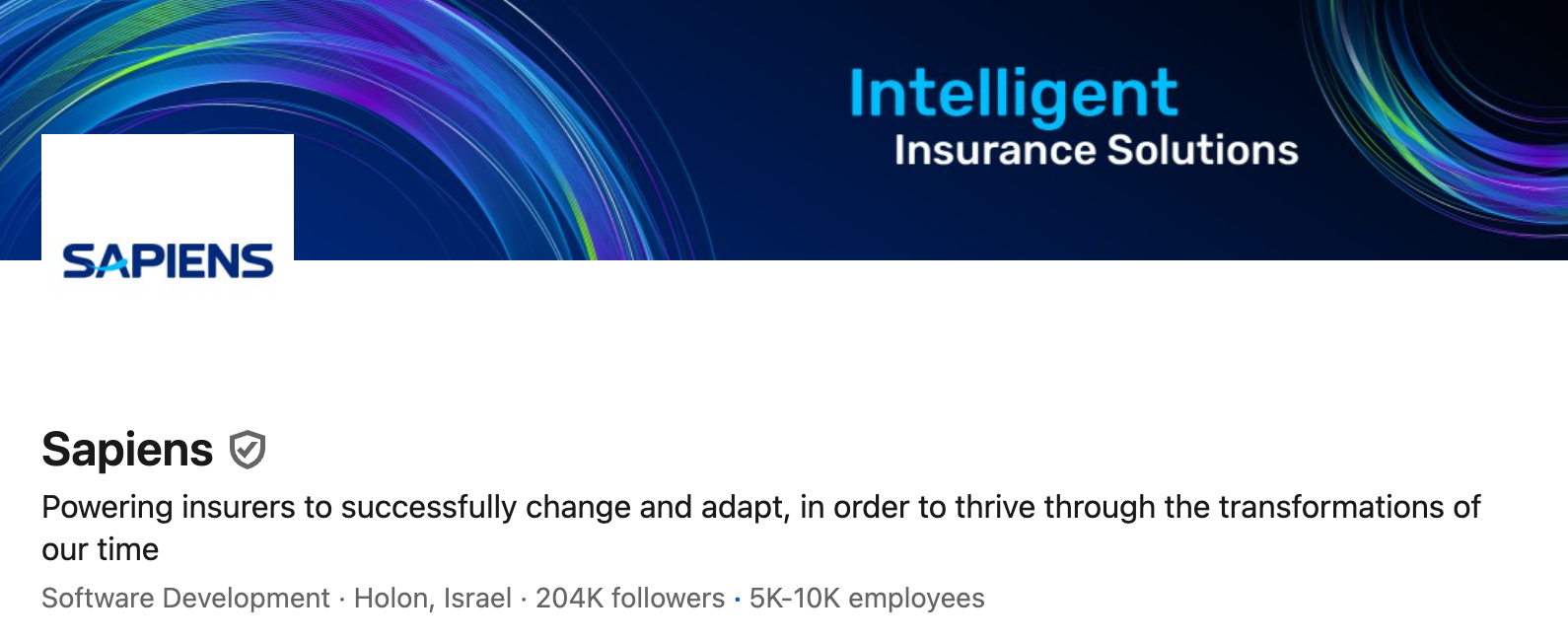
Sapiens is a global company in intelligent insurance software solutions. The company operates in more than 30 countries, having more than 5000 employees. Sapiens is headquartered in Holon, Tel Aviv, Israel and was founded in 1982.
Some of their main specialties are Insurance Software Solutions, Innovative Business Decisions Management System, Insurtech, Fintech, and Financial, Compliance, and many more.
On LinkedIn, Sapiens has 204K followers and 4.9K associated members. Most of their employees are working as engineers (1.678 people), followed by information technology (835 people). We do not see any employee who works in the marketing department, but they have 134 sales professionals. This makes our analysis even more interesting. Let’s start with their brand promise.
Brand promise

Sapiens’ brand promise revolves around empowering insurers to grow, differentiate, and stay ahead through intelligent, open, and future-ready insurance solutions. We can also see that The Sapiens Insurance Platform is central to their promise.
Some of the keywords they use are: “AI-based”, “open and integrated”, and “growth and success”. They promise solutions designed for today and tomorrow, emphasising cloud-native technology, scalability, and adaptability to evolving needs. Sapiens promises to be the intelligent partner that helps insurers grow, differentiate themselves, and prepare for the future.
Below, they underline the idea of having “unmatched industry expertise”. This builds trust and credibility and it assures potential clients that Sapiens not only has technological capabilities but also a deep understanding of the insurance domain.
Sapiens’ Solutions and Products
Their solutions are listed at the bottom of the main page, spanning in 6 directions:
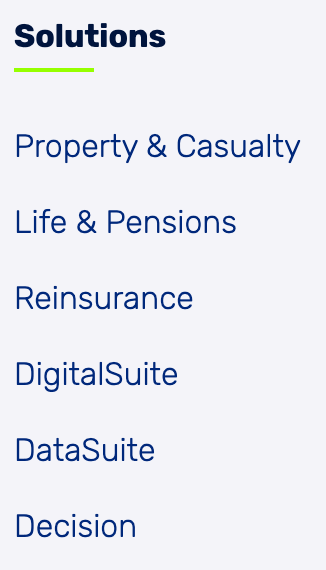
Their main product is the Sapiens Insurance Platform which comprises foundational capabilities, such as digital engagement, SaaS/Cloud, Data, AI & Analytics, Security, and others.
How do they differentiate themselves
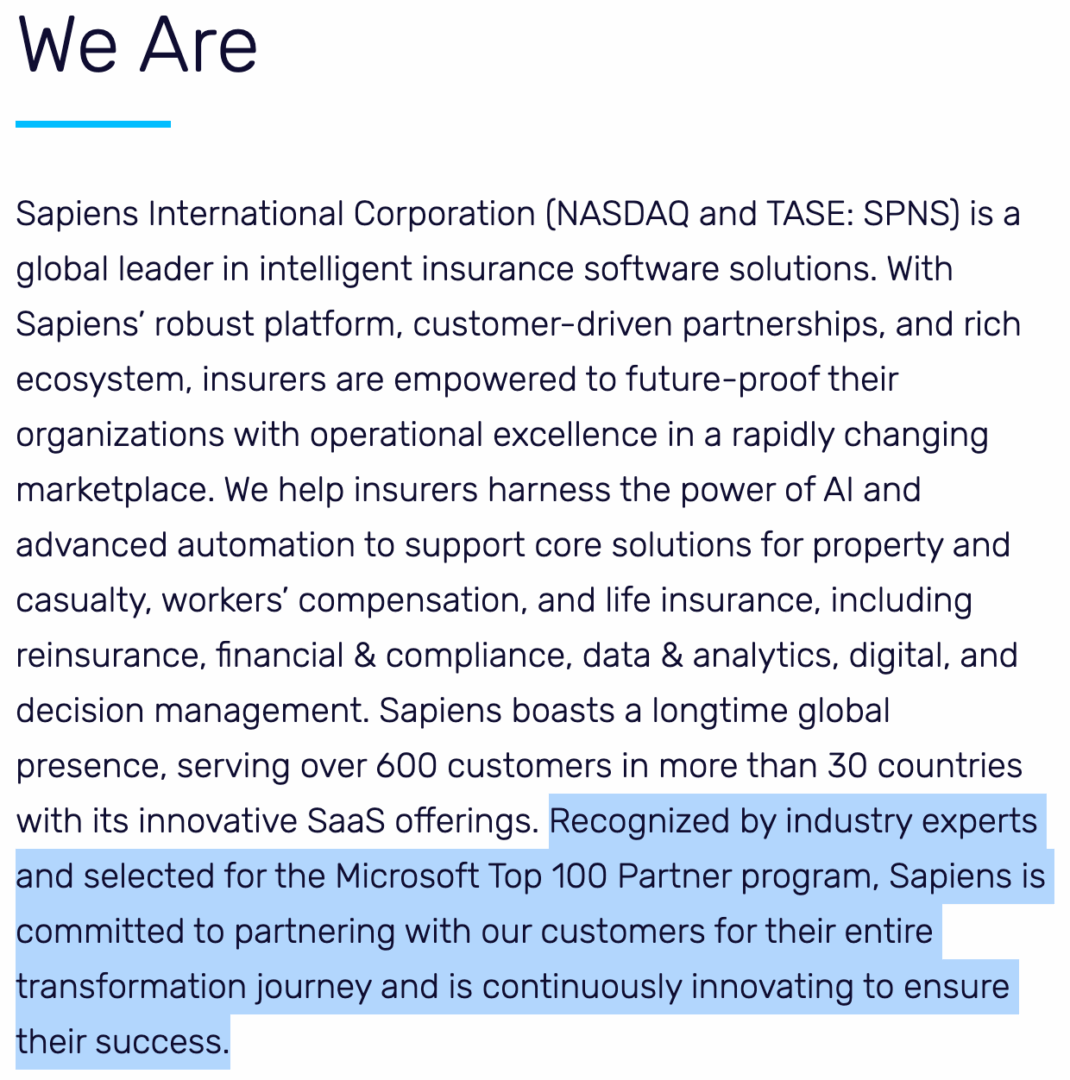
In the highlighted area, we have noticed something that they might consider their differentiator. The mention of being “recognized by industry experts” (likely referencing awards and analyst reports) and being selected for the Microsoft Top 100 Partner program establishes credibility and validates their expertise. These are external endorsements that build trust.
We also like this idea and how they put it into words: “Committed to partnering with our customers for their entire transformation journey”. This puts Sapiens not just as a vendor, but as a long-term strategic partner invested in the customer’s success. You might have heard this phrase 1000 times: “long-term strategic partner”. This is a cliché, and while the idea behind it is good, the phrase has become so overused that it often loses its impact.
In enterprise software implementations, the relationship between vendor and client is really really important. A true partnership implies collaboration, trust, and shared goals, which are essential for successful transformations. It’s not just about buying software.
Conclusions
AI is clearly a central theme in their messaging, positioning them as a forward-thinking and innovative player in the insurance tech space. One of the main goals for selling on LinkedIn or anywhere, is important to be credible. And how do they try to become credible? One idea is to show their recognition from industry experts and Microsoft.
Also, the lack of visible marketing employees on LinkedIn, coupled with a substantial sales team, suggests a potential reliance on direct sales efforts. This might indicate a gap in broader marketing strategies like content marketing or digital marketing.
The brand promise speaks about the concerns of companies: growth, differentiation, and future-proofing their business.
Now we will move on to social media analysis. Namely we will analyze the company’s activity on LinkedIn and other social media channels. Of course, we will also analyze the social media presence of the C-lvl executives.
Social Media
Leadership social media activity
1. Sapiens’ CMO – Yaffa Cohen-Ifrah

The CMO has 8,571 followers on LinkedIn and from what we can see, she is active on this platform, by posting every week. That’s a lot of effort but it shows she is committed to grow and improving the image of Sapiens.
First off, she focuses on promoting Sapiens services. For this we see she is using a text + image format. Her posts have a CTA at the end, encouraging readers to check how Sapiens can help.
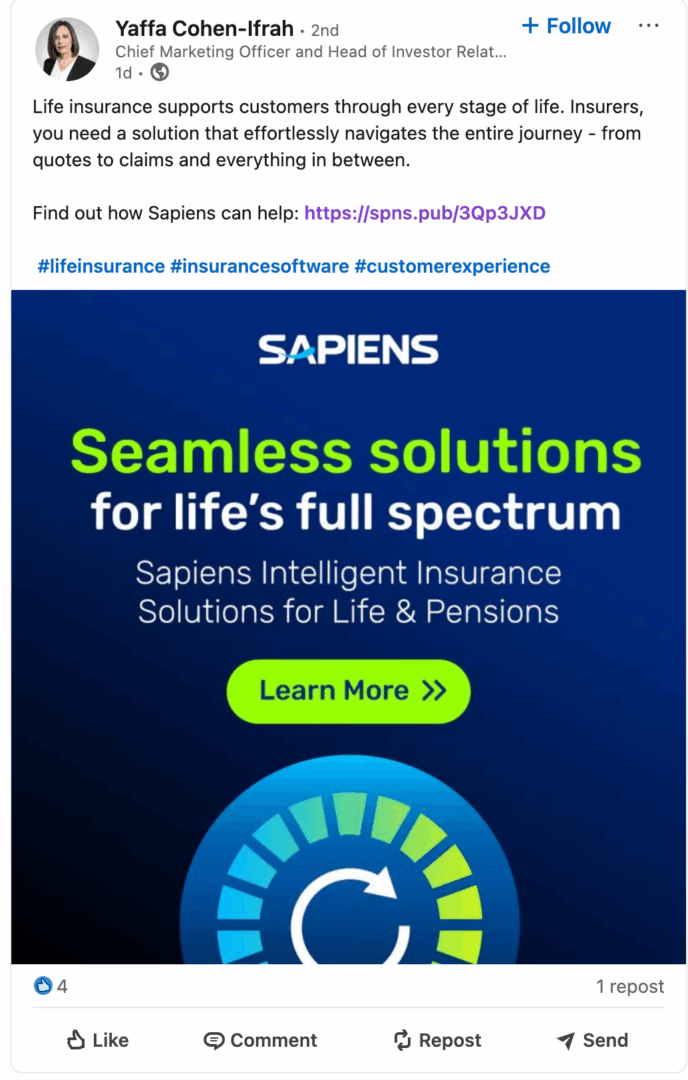
This post focuses specifically on life insurance and the challenges insurers face in managing the customer journey. This suggests a targeted content marketing approach.
The link attached sends the leads to a landing page dedicated to life insurance. At the bottom of the page, there is a contact form. This approach allows Sapiens to capture valuable leads from potential clients who have demonstrated an interest in their life insurance offerings.
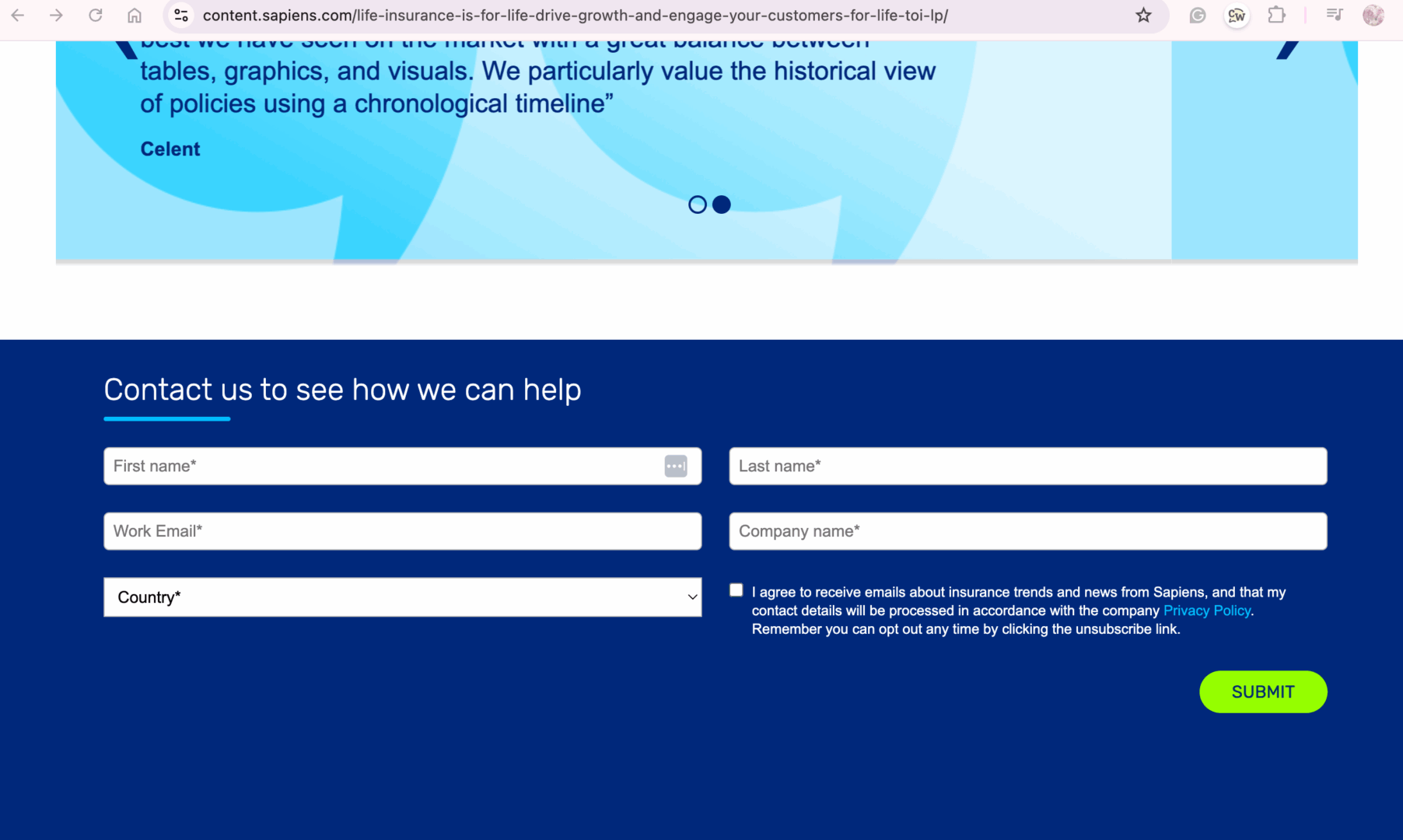
Another pillar we observe on her LinkedIn profile is the promoting Sapiens partnerships. For example, in this post below, the CMO promotes the collaboration between Earnix and Sapiens.
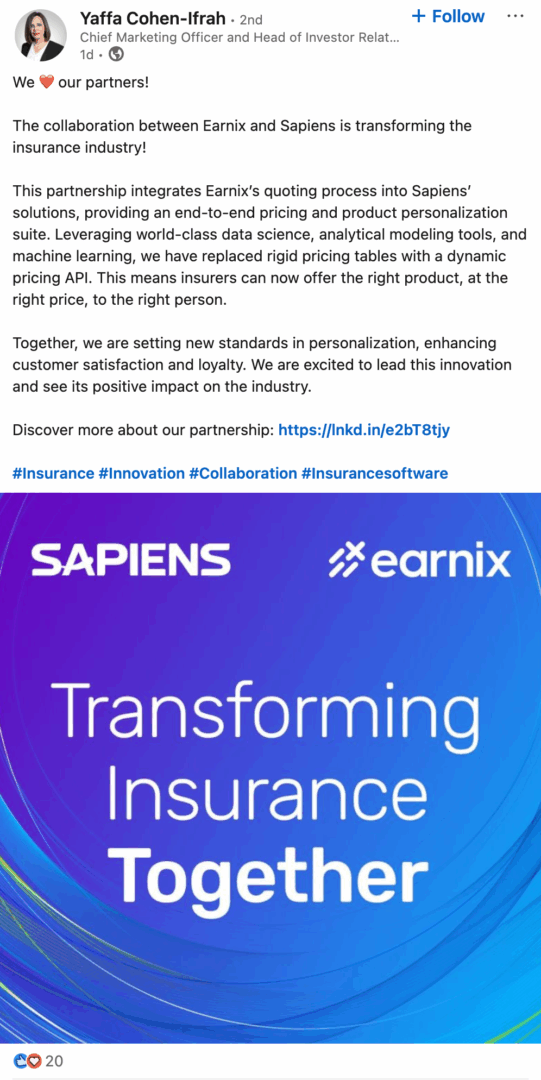
The CMO also posts about Sapiens’ participation in events. We also noticed that sometimes she posts the exact same description and image as Sapiens’ page, like in the example below.
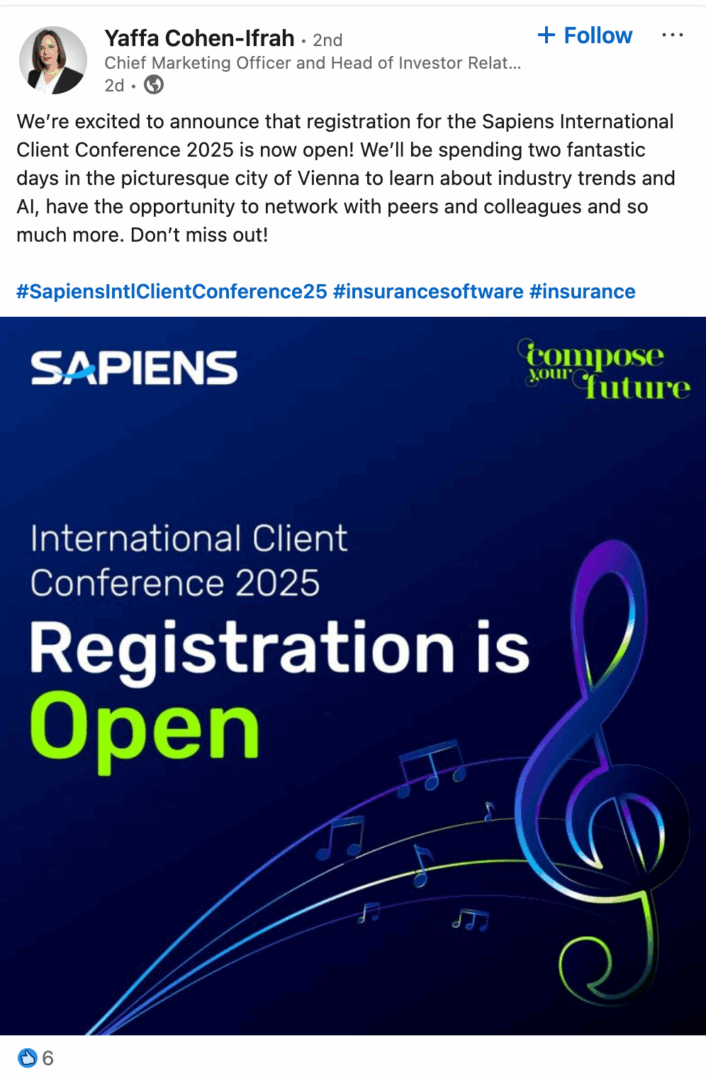
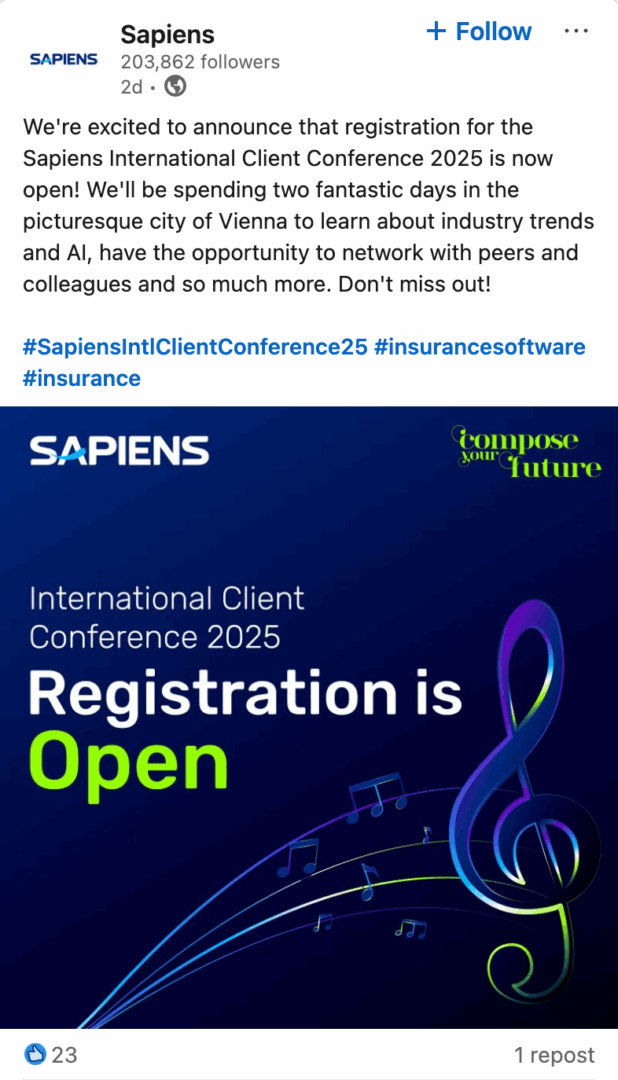
The CMO also posts content related to her personal beliefs. See example below.

The CMO promotes Sapiens’ content (blog posts, videos, etc.). This is a classic content marketing strategy, offering valuable content (the webinar) in exchange of contact information. The repeated promotion of the webinars suggests that the CMO is repurposing content to maximize its reach and impact.
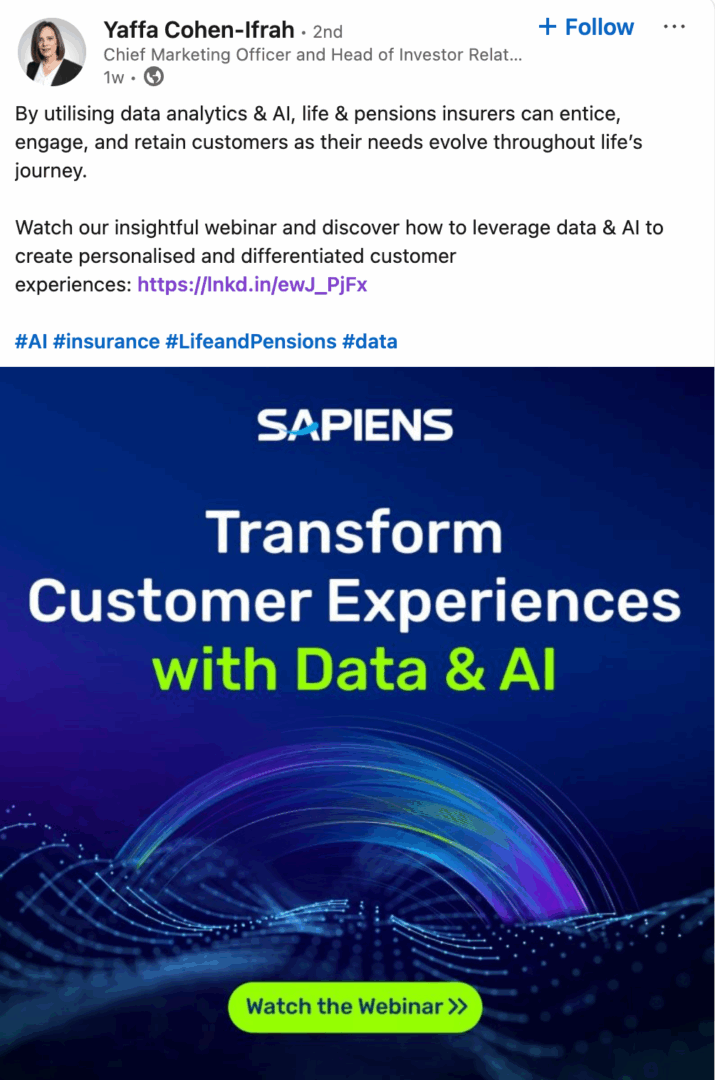
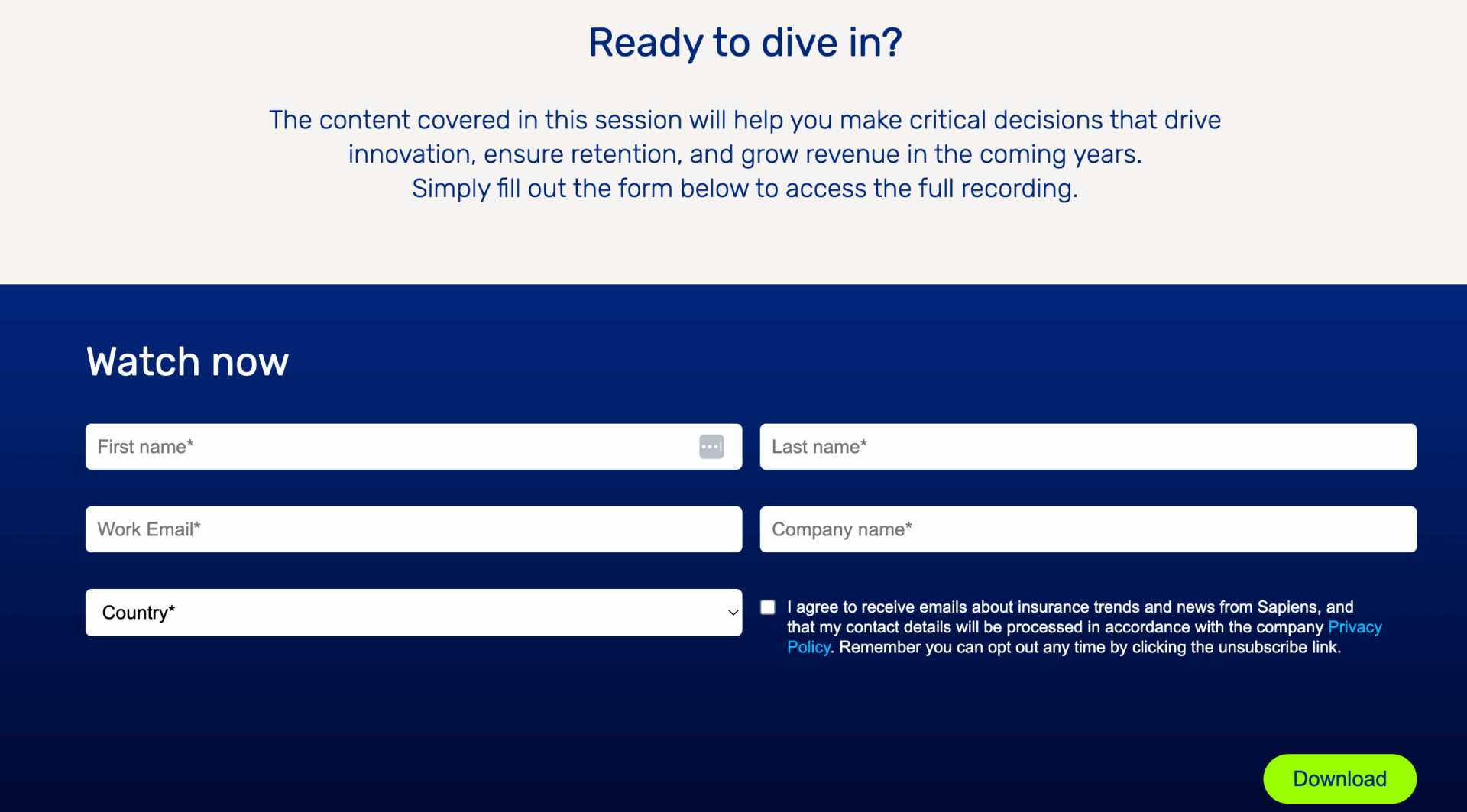
The engagement at her posts is quite low, rarely going over 40 reactions. In terms of commenting we can see that the CMO is engaged in interacting with others, although it is a limited interaction and quite basic, and most of the comments are simple congratulations.
Overall, the CMO seems very committed to promoting Sapiens and its services. The consistent posting of content related to Sapiens’ offerings, partnerships, events, and thought leadership demonstrates a clear dedication to promoting the company and its value proposition.
Sapiens’ company social media presence
Now that we have analyzed the CMO’s activity, it is time to focus on the company’s social media presence.
How often do they post?
Sapiens is really active on LinkedIn. Looking at the last three months, they’ve been posting an average of 39 times a month, and that’s a lot! It seems like they have tons of content and are putting in a serious effort on LinkedIn.
Let’s see what are their best performing posts:


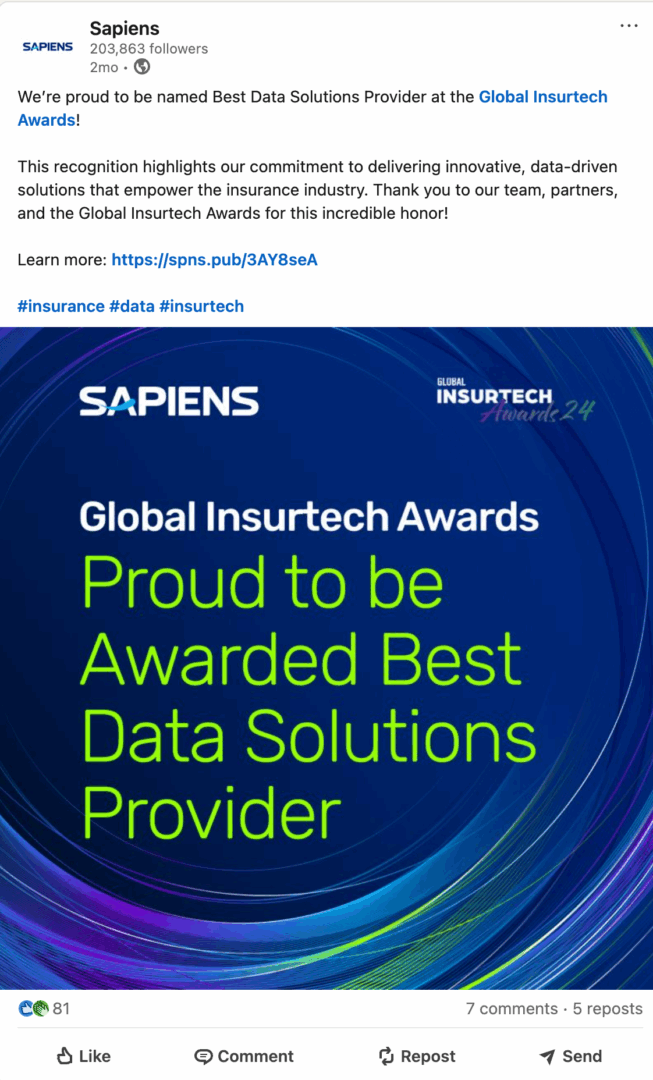
Their best-performing posts aren’t usually about their services or products. The ones that get the most likes tend to focus on company values, culture, community, and employee recognition. It shows that people connect with people, not just products. Posts that highlight the human side of Sapiens, like employee appreciation, community events, or customer gatherings, make the company feel more relatable and approachable. Even though these posts are part of their marketing strategy, they come across as more authentic than direct product promotion.
What is their content format?
They mostly use text and images, or sometimes just images and videos.
What is their engagement level?
Sapiens has 204K followers on LinkedIn, which sounds impressive, but their posts usually get less than 20 reactions. Comments are pretty rare, though they occasionally get a few reposts. The reposts are mostly from Sapiens’ employees.
What are their content pillars?
Now let’s see what they post about.
1. Promotional content

Their post is promotional because they are highlighting their sponsorship of the podcast. This exposes their brand to a wider audience and associates them with valuable content. However, the core message is still about the podcast itself, which offers educational value. It’s a subtle form of promotion.
Sapiens does promote their services on LinkedIn, too. For example, in this post, they’re focusing on their mortgage industry solutions. They’re highlighting how their tools can improve underwriting efficiency and driving traffic to their website to generate leads. We even checked out the link in the post and went to their dedicated landing page for this service.

Same idea we see for their Reinsurance services.
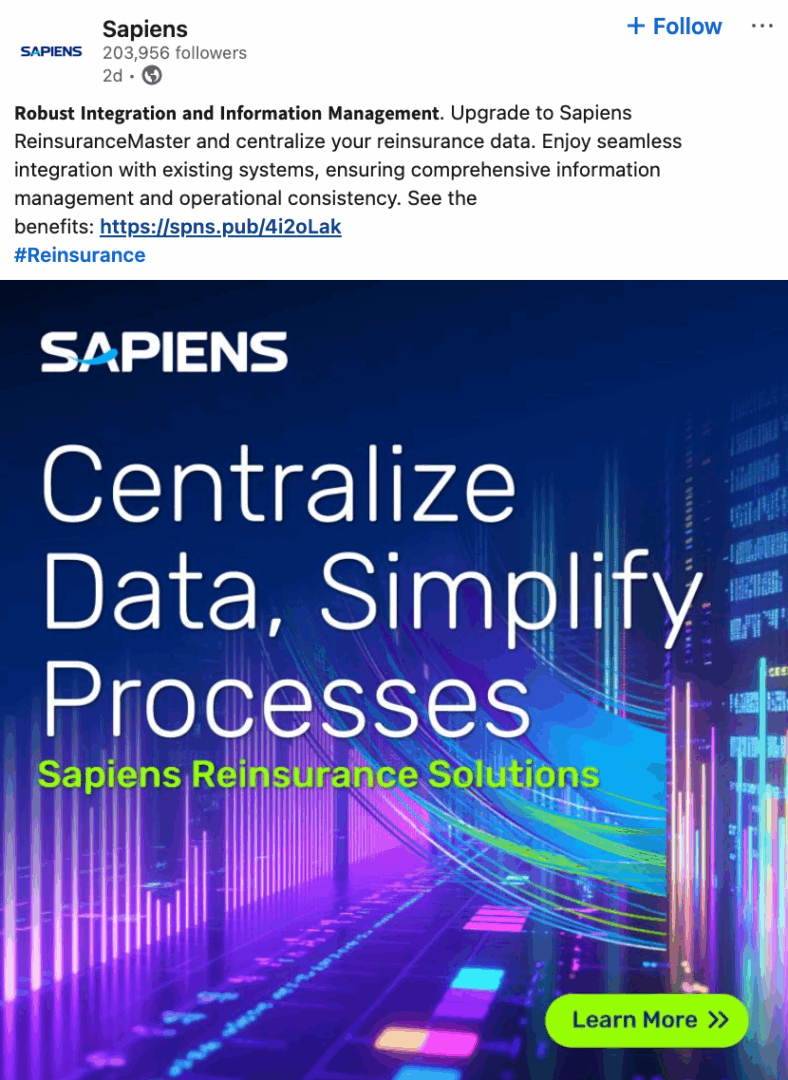
2. Events/Conferences (with a healthy dose of Brand Awareness)
For this pillar, we have the following example:
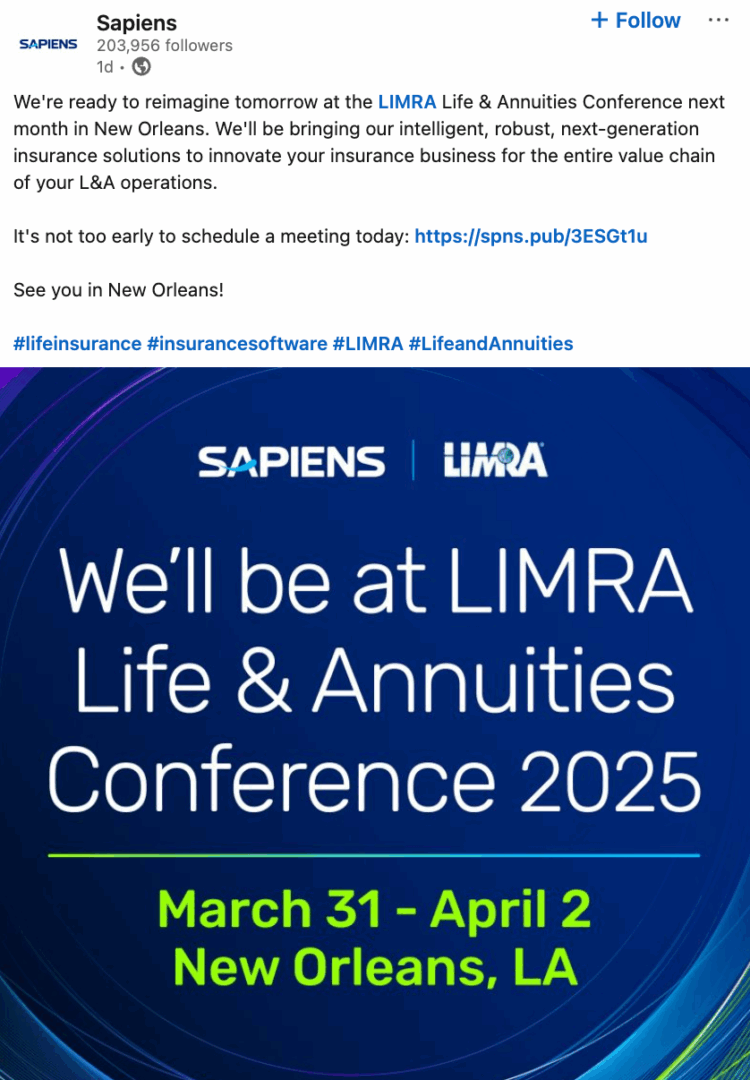
They’re letting everyone know where they’ll be (LIMRA conference), what they’ll be showcasing (their insurance solutions), and what they’d like you to do (schedule a meeting).
So, the next logical step is their meeting scheduler. They’ve announced they’ll be at LIMRA, and now they’re making it easy for people to actually connect with them while they’re there.
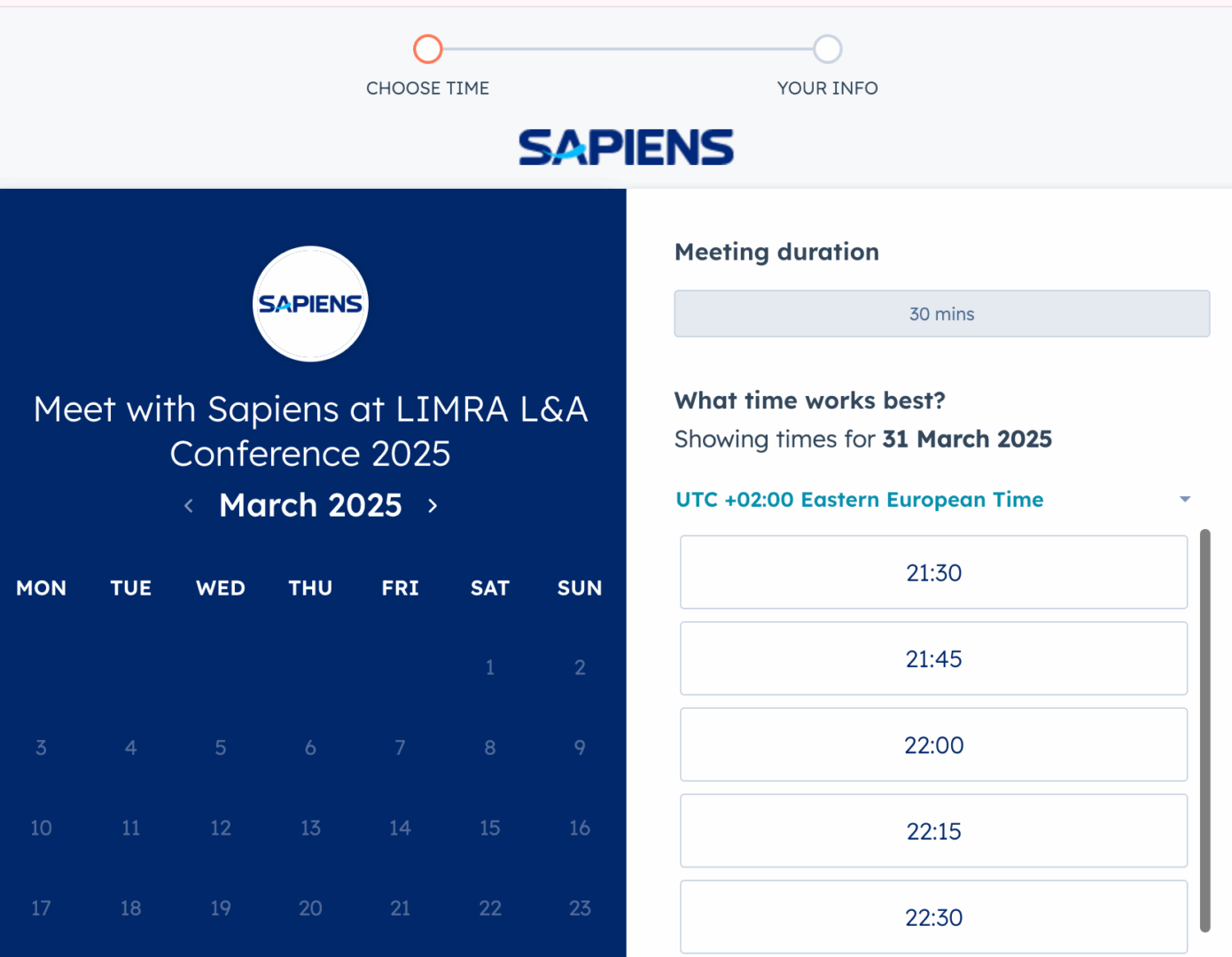
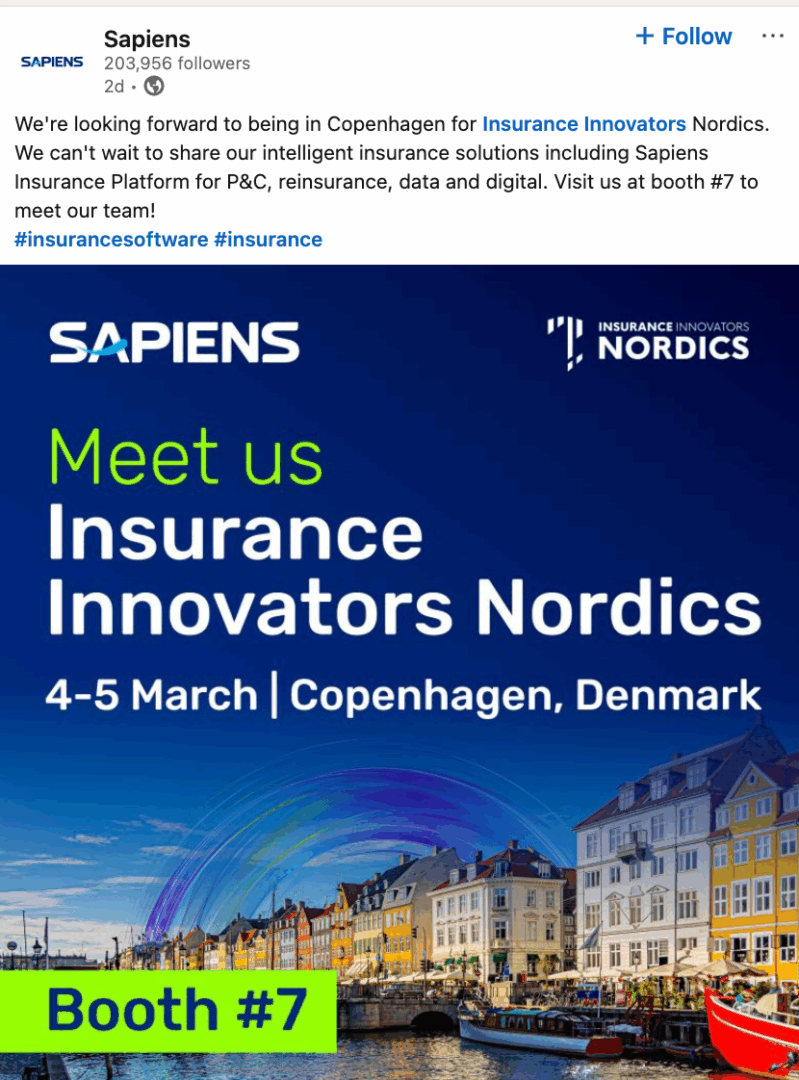
3. Thought Leadership
They also share their blog posts on LinkedIn. These posts usually include a nice visual, a short description, and a clear “Read the blog” call-to-action, which takes readers directly to their blog.
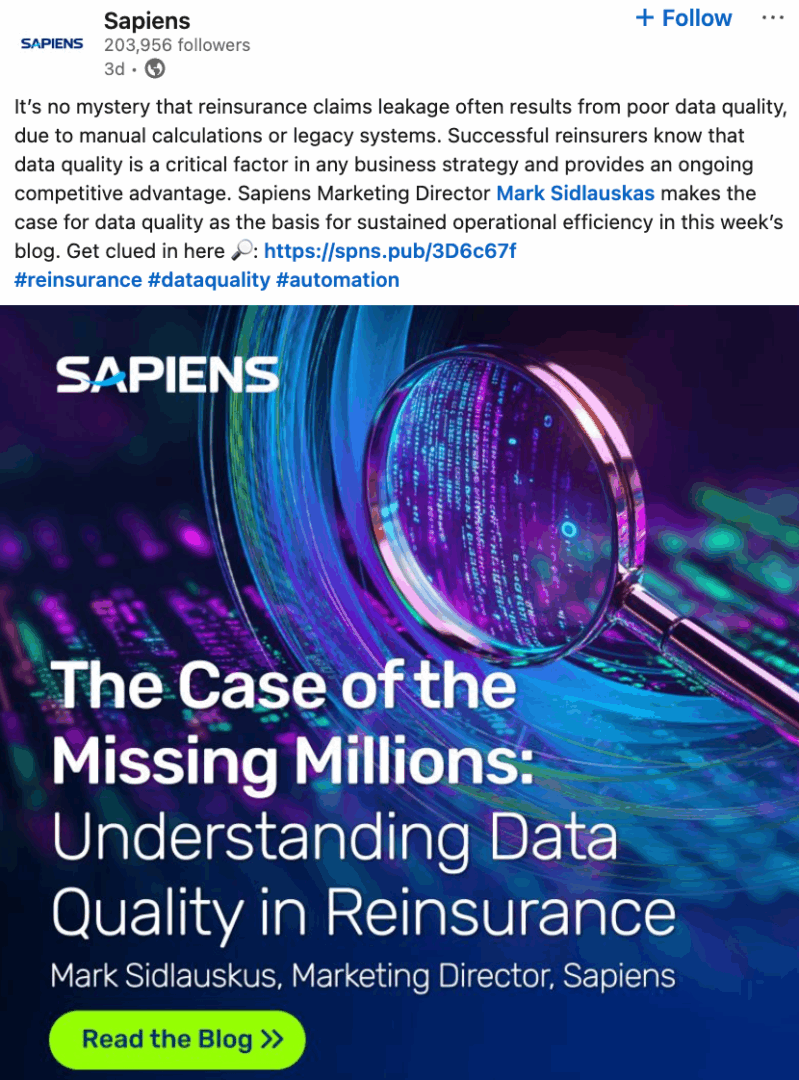
4. Financial News
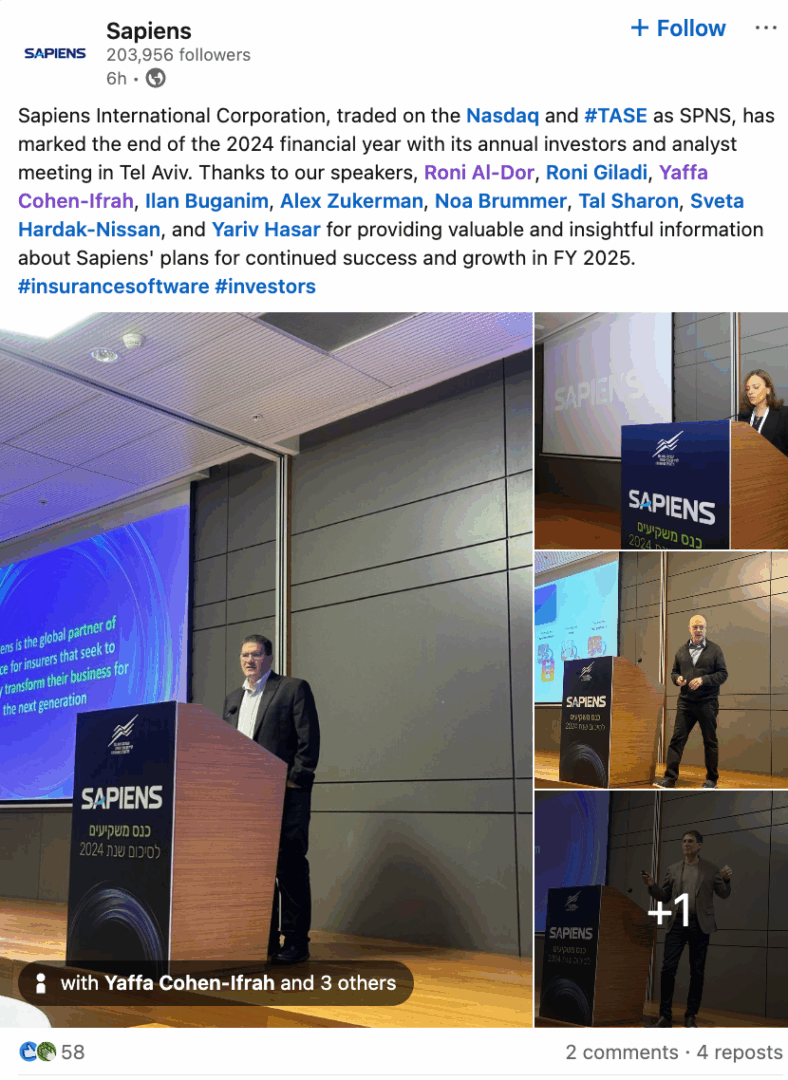
The content is clearly created for investors, analysts, and others interested in the financial performance of Sapiens.
5. Events/Webinars
Sapiens is promoting their upcoming webinars. While it also touches on Industry Insights/Thought Leadership, the primary purpose of the post is to drive registrations for the webinar.
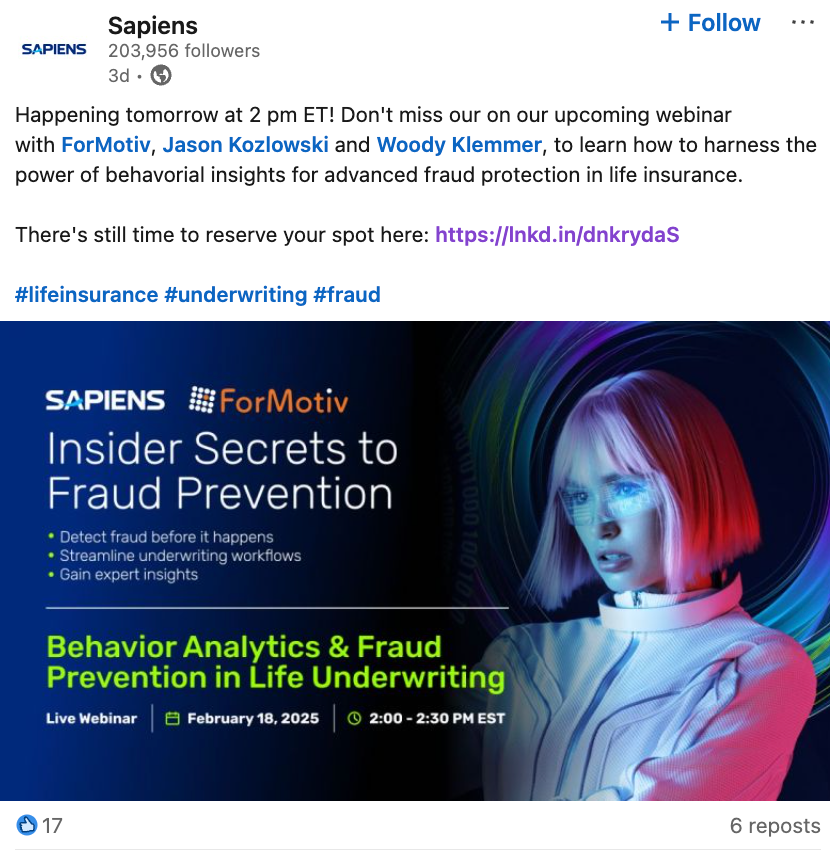
The “Reserve your spot here” call-to-action link takes leads to a webinar registration page.
6. Partnerships content
We can see that Sapiens is promoting their partnerships and tags their collaborators on LinkedIn.
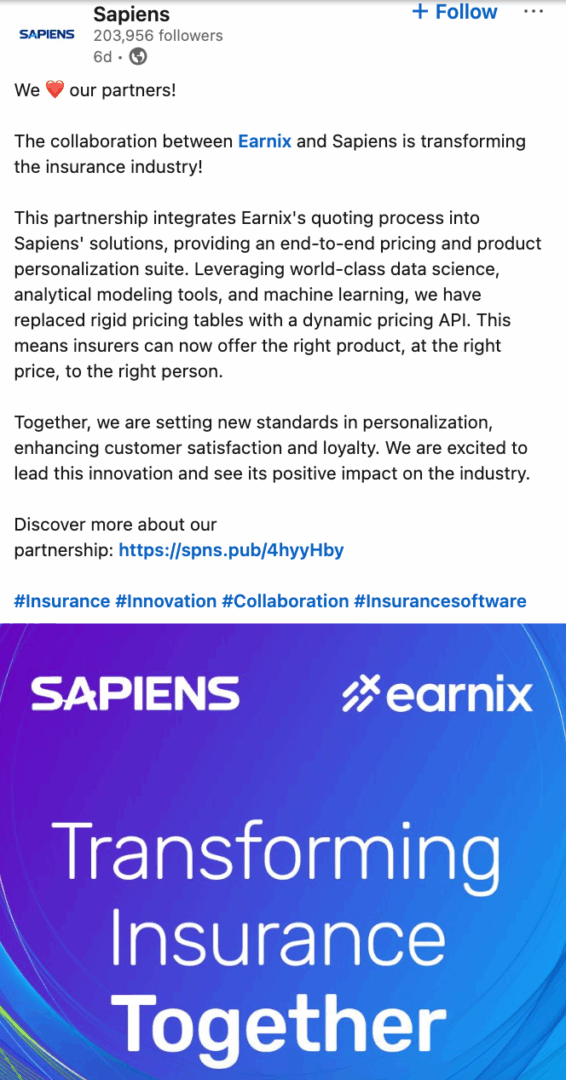
This post is a good example of Partnerships/Alliances content. It highlights the collaboration between Sapiens and Earnix and explains the benefits of this partnership. While it also touches on Product/Solution Promotion (by mentioning the integrated pricing suite), the core message is about the partnership itself and its impact on the insurance industry.
7. Company updates / News
Within this content pillar, Sapiens is announcing specific updates to their products.
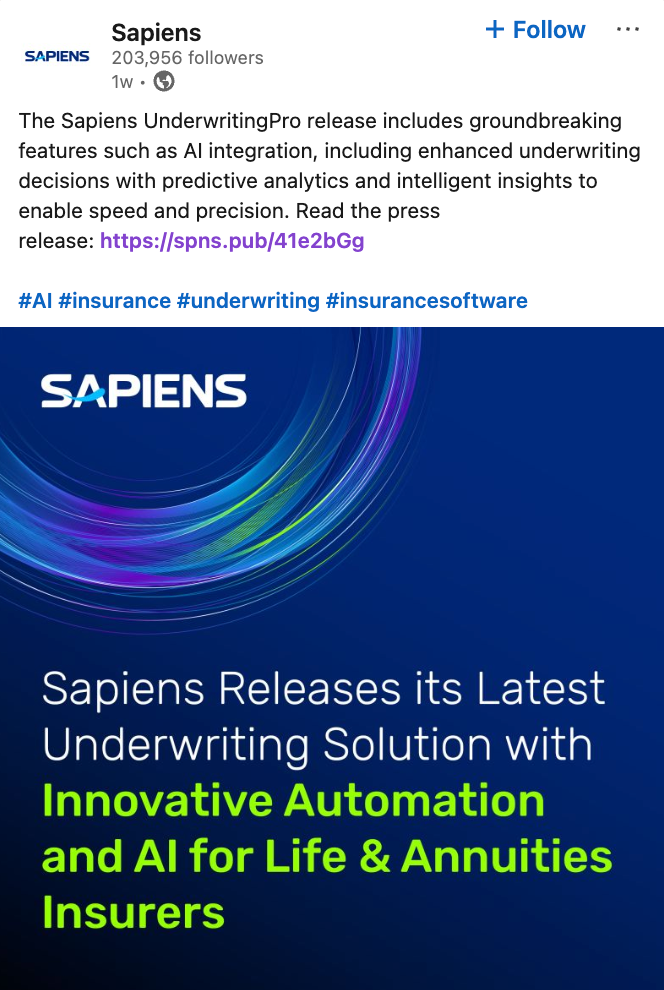
Overall strategy
They use various tactics to capture leads, including webinar registrations, meeting schedulers at conferences, and clear calls-to-action in their posts. Lead generation seems to be the main activity on LinkedIn.
Their strategy on LinkedIn also contains thought leadership content in form of blog snippets.
We see that they track where is their traffic coming from: https://sapiensdecision.com/industry/mortgage?utm_source=linkedin&utm_medium=social&utm_term=87e423d5-f6cd-4885-a030-8f4206254dd2&utm_content=sapiens&utm_campaign=managing_pc_complexity
utm_source is a parameter used in URLs to track the source of your website traffic. By using utm_source, marketers can see which sources are driving the most traffic to their website and which sources are most effective at generating conversions.
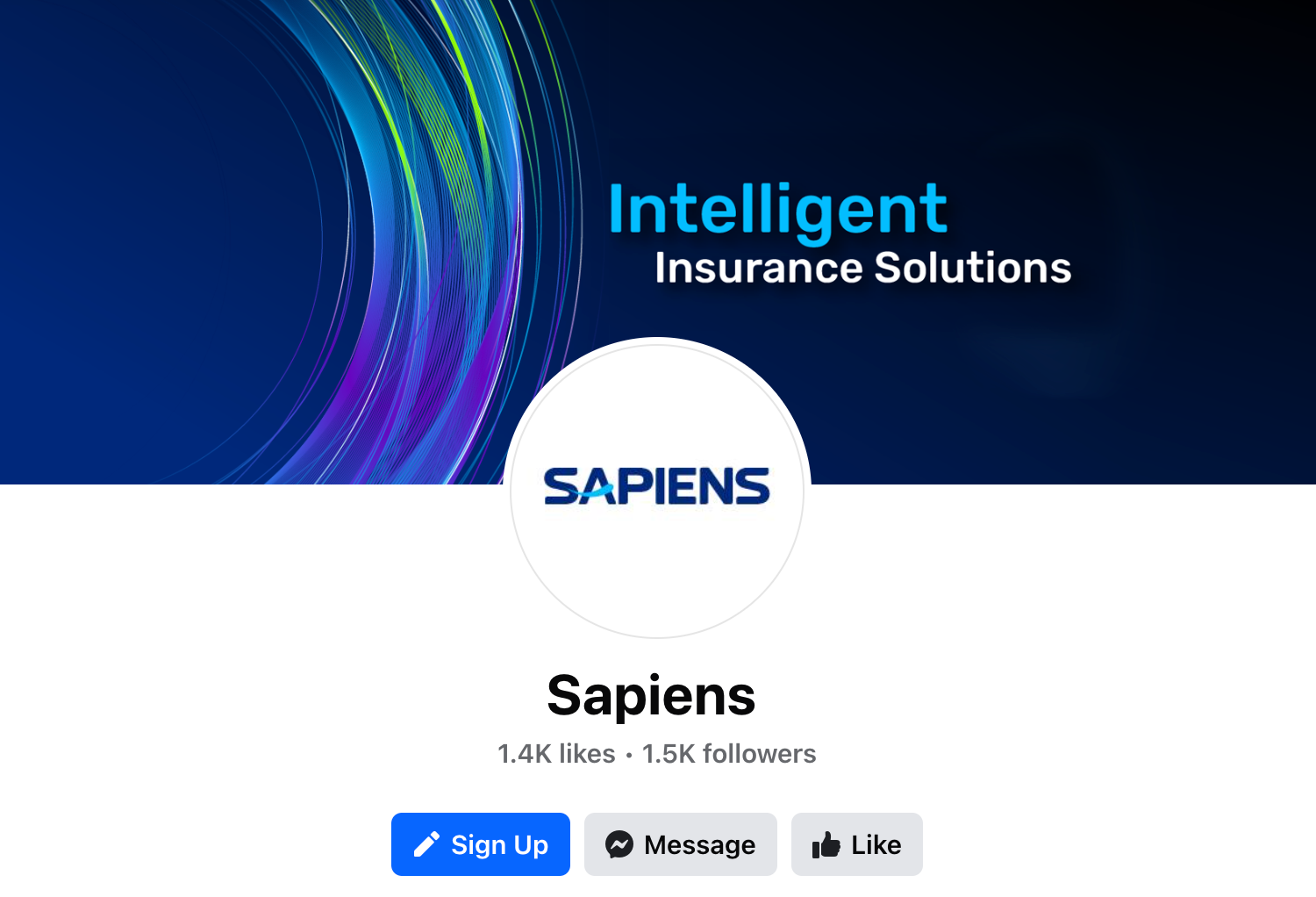
The Facebook presence of Sapiens is quite different from their LinkedIn profile. They have 1.4K likes and 1.5K followers, which is significantly less than their 204K followers on LinkedIn. They seem to post a few times a week, but not nearly as often as they do on LinkedIn. It looks like they’re often repurposing content from LinkedIn, using the same descriptions and visuals. Essentially, they’re sharing some of the same types of posts: blog posts, insurance platform updates, and service promotions, but not everything they post on LinkedIn makes it to Facebook. The engagement is very limited, with zero to just a few likes per post.
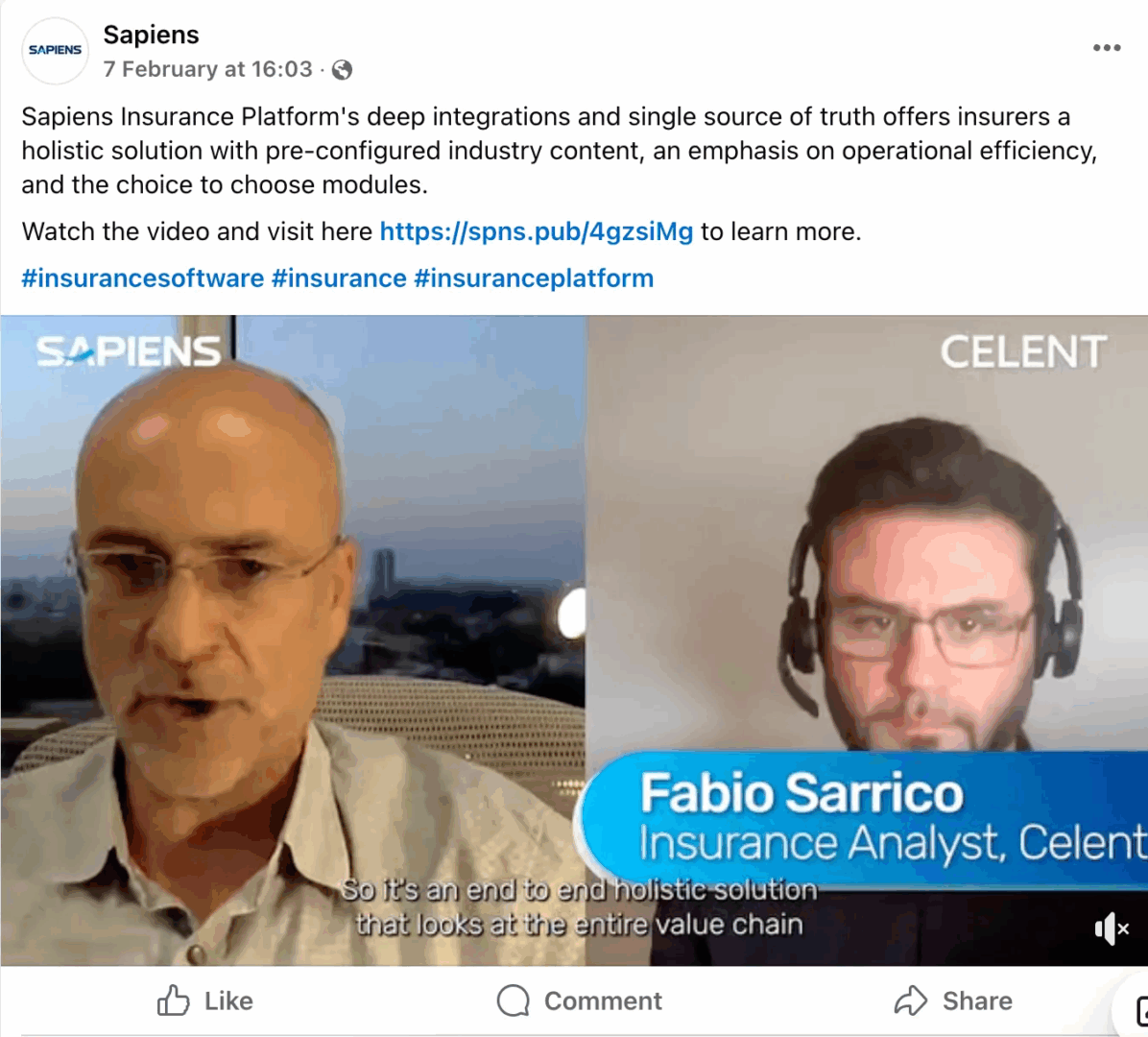
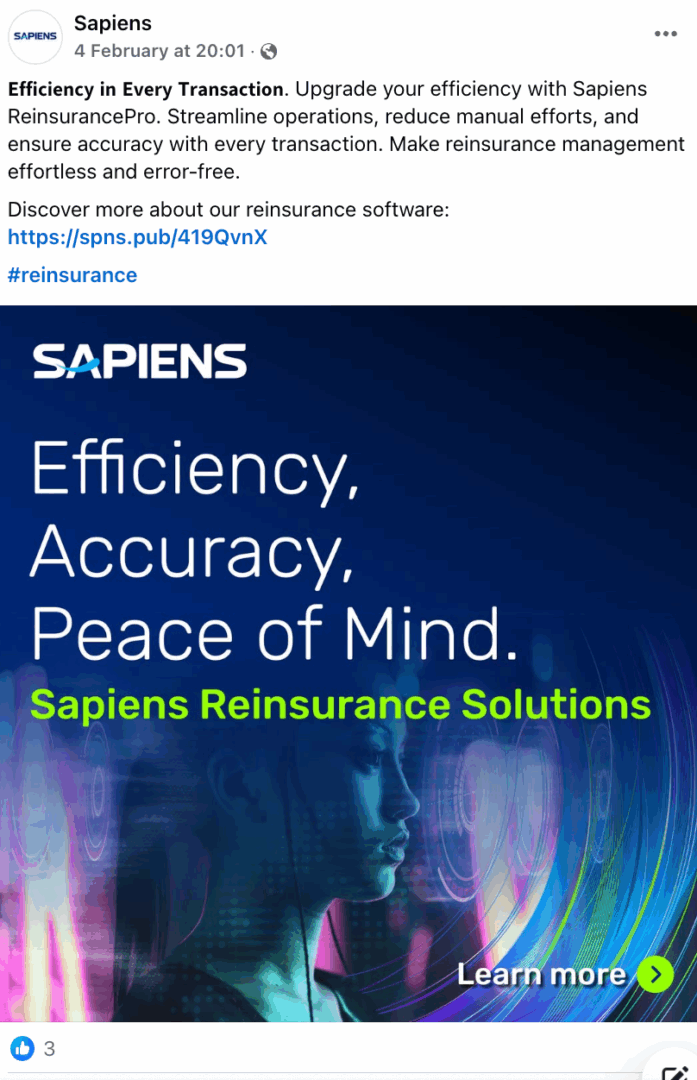

Sapiens’ Instagram presence tells a different story. Here, they have about 1.2K followers, and their bio link goes straight to their career site, not to their services, products, or blog. This suggests they might be using Instagram more for talent acquisition. It definitely seems less focused on lead generation and more on building their brand and highlighting their company values.
Their content seems to center around diversity, equity, and inclusion (DE&I), corporate social responsibility (CSR), learning, and company events. They also feature stories from different countries and continents, emphasizing their global reach and inclusive culture. They post Reels and images that show life at Sapiens.
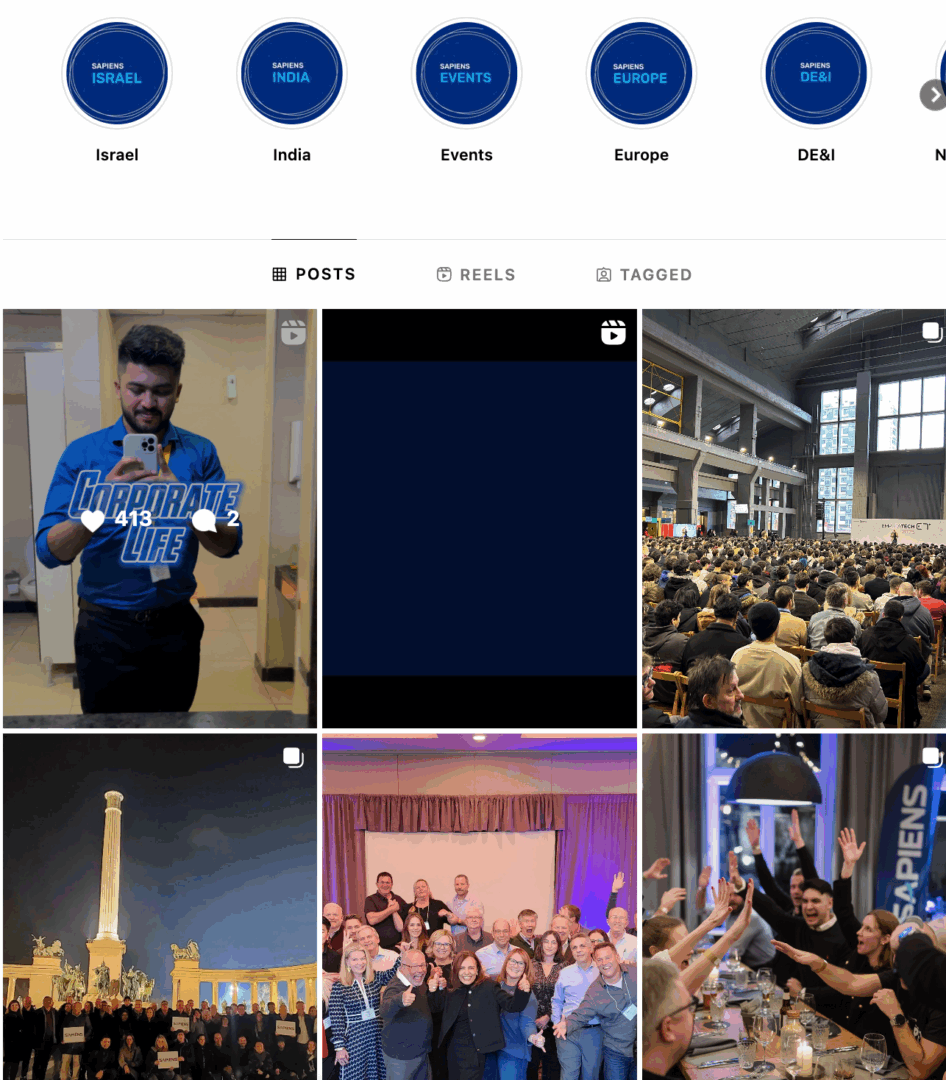
For instance, the latest Reel in the picture focuses on corporate life from an employee’s perspective.
They post a lot of content from conferences, parties, and other company events. Their posts generally get fewer than 50 likes, though some do better. Their posting schedule seems a bit inconsistent, with some months where they post daily, while other months they barely post at all.
X (ex-Twitter)
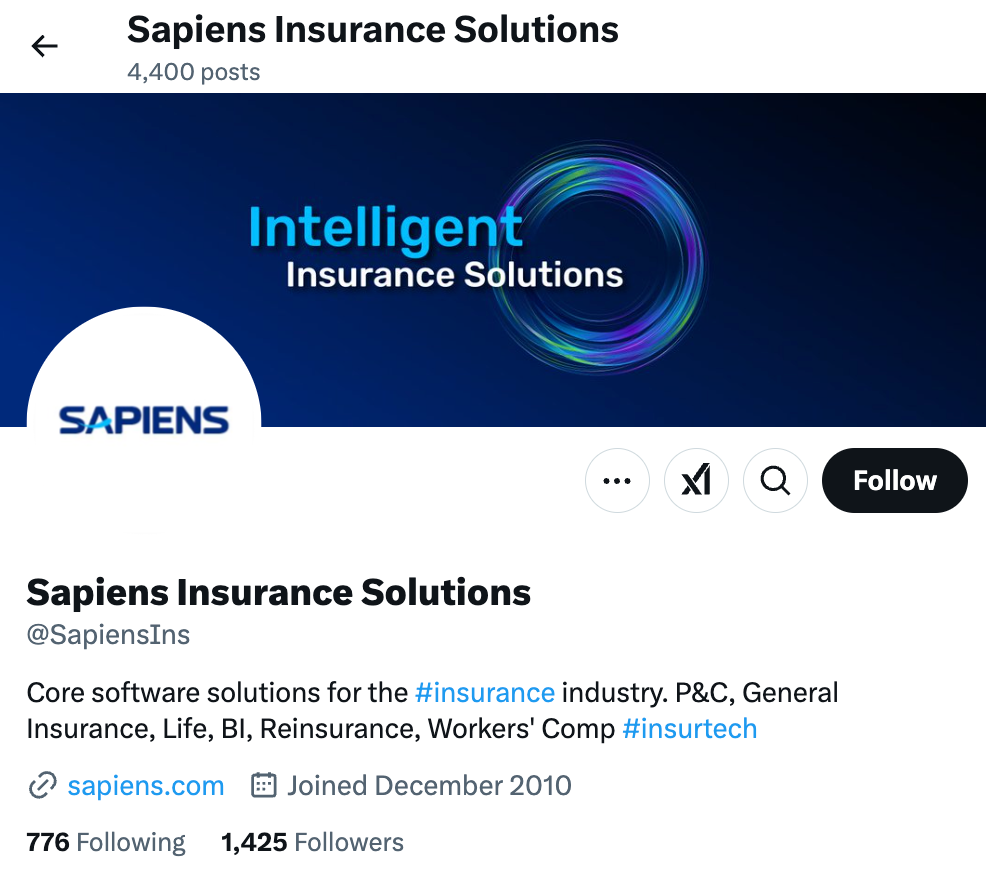
X (ex-Twitter) is slightly more popular than Instagram for Sapiens, with around 1.4K followers. Interestingly, while they use the same visuals as on LinkedIn and Facebook, they write different descriptions for their X posts (see the example on the left). So, they’re essentially sharing the same core content but tailoring the text for X platform.
Their posting schedule seems pretty random, though; no real content calendar in sight. Engagement is still low, with most posts getting around 40-50 views.
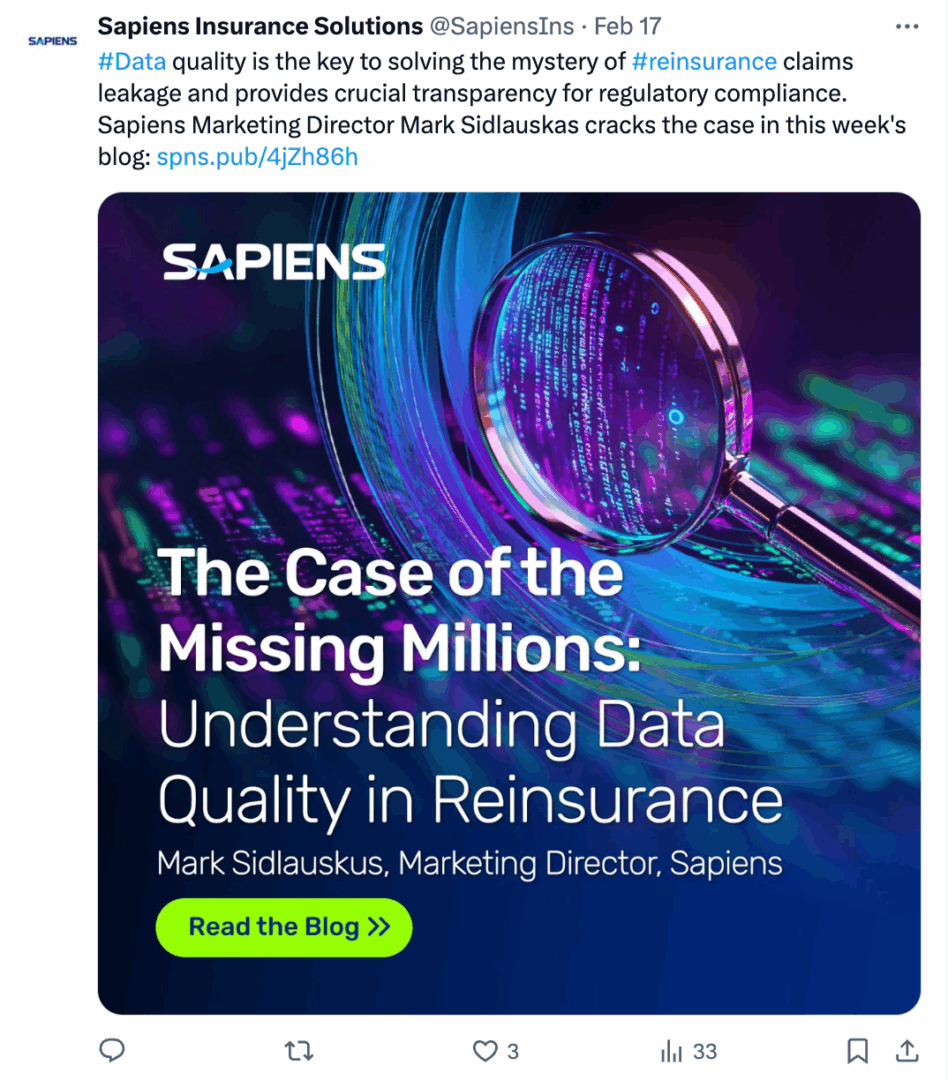
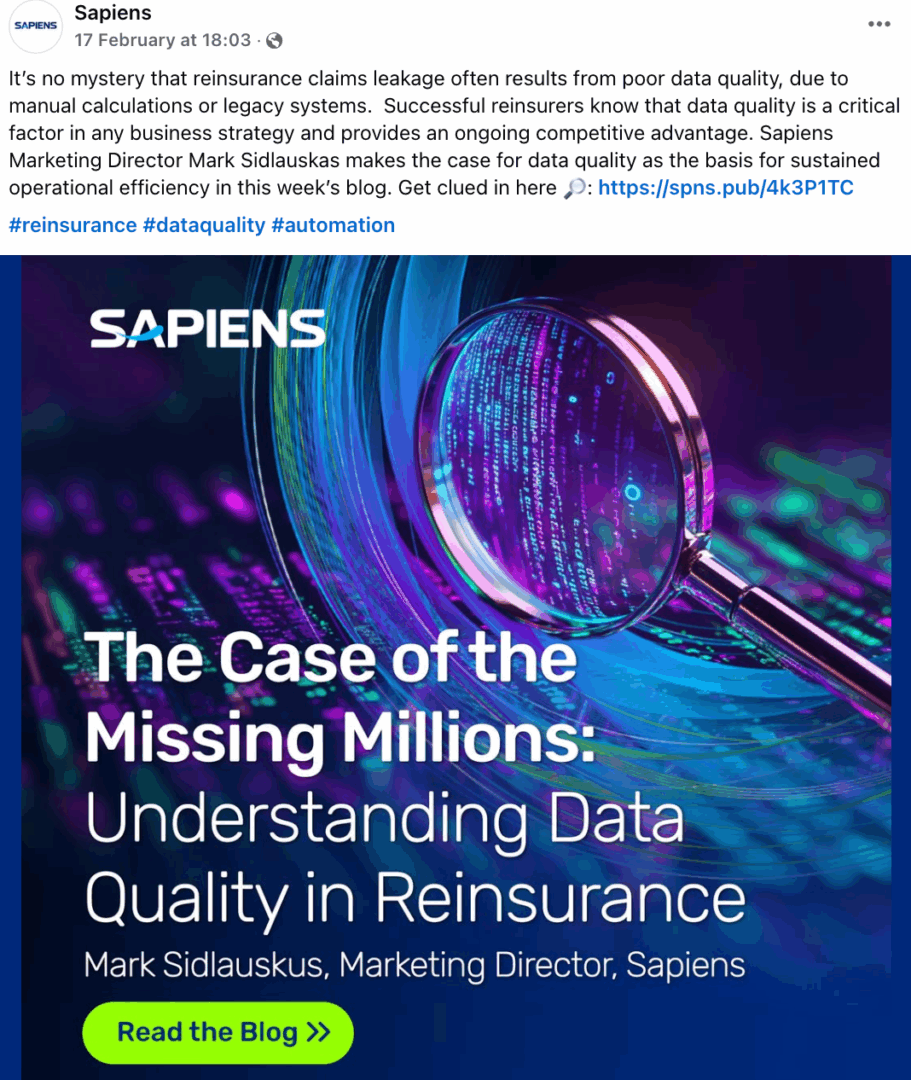
YouTube

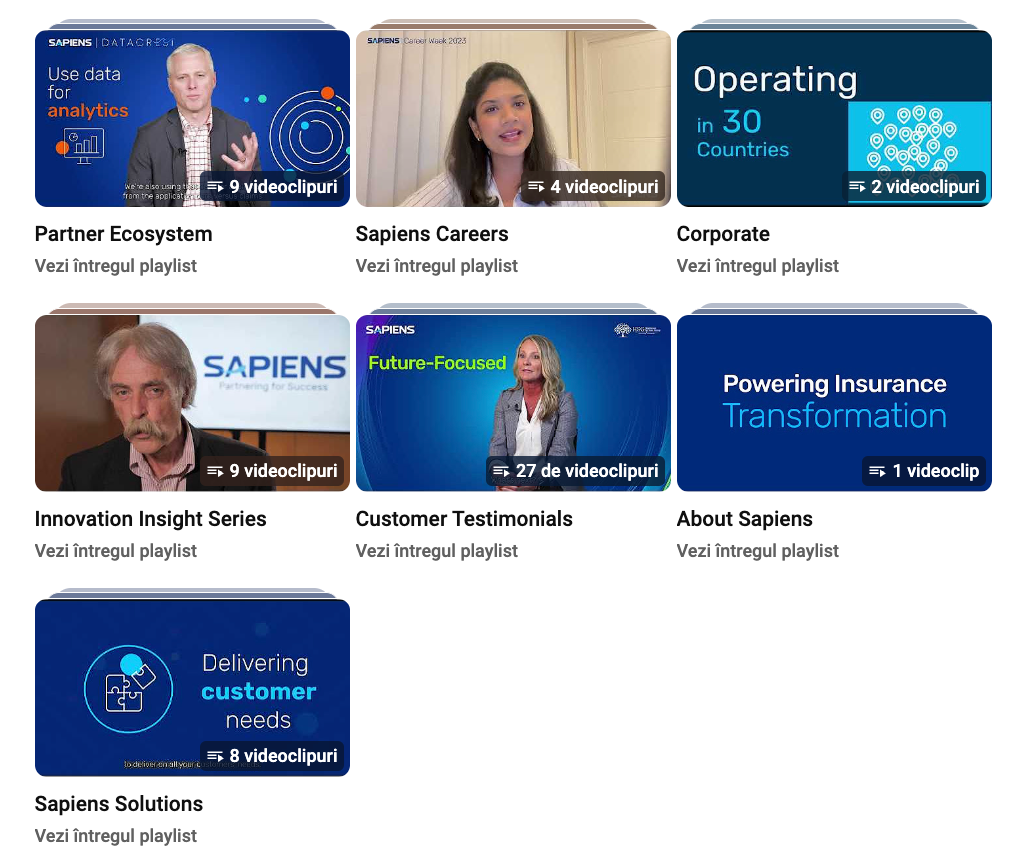
Their YouTube channel currently has 726 subscribers and features 7 playlists, with the most popular being “Partner Ecosystem” and “Innovation Insight Series.”
Some of their videos include clients testimonials, such as this one:

Most of their videos are brief, with very few that extend to 30-40 minutes. The channel has a total of 64,848 views across 143 videos, averaging approximately 453 views per video. They add a CTA in the description of their videos like “Learn more at sapiens.com” to drive traffic to their website.
Conclusions
Sapiens is trying to have an active presence on all platforms, and use them for different purposes. LinkedIn is the primary platform for B2B marketing and networking. Its user base is for professionals, making it ideal for reaching decision-makers in their industries. Instagram is more for attracting talent and humanizing the brand. And lastly, YouTube might be used for generating demand.
Sapiens’ content on LinkedIn is often personalised to attract specific leads, meaning that they connect a service/solutions/ for each industry they activate. For example:
- Property & Casualty (P&C) insurers: IDITSuite for P&C, Sapiens Insurance Platform for P&C.
- Life & Annuities insurers: UnderwritingPro, CoreSuite for Life & Annuities.
- Mortgage lenders: Sapiens Decision.
- Reinsurers: ReinsuranceMaster.
- Investors: Here they talk about financial results, investor meetings.
On LinkedIn, their posts include various calls to action, such as: “Read more”, “Learn more”, “Register today”, to attract and generate leads.
As we’ve seen, Sapiens often repurposes content across different formats and channels. For example, they’ll summarize blog posts for LinkedIn or promote webinars through multiple posts. This suggests they’re trying to get the most mileage out of their content. While it’s understandable, creating new content can be resource-intensive. Different platforms have unique formats, algorithms, and audience expectations. Simply repurposing content without tailoring it to these specifics can lead to low engagement.
Now let’s move on at analyzing their content marketing strategy and what strategy they use to generate leads.
Demand generation
In this section we will have a look at their blog posts, case studies, videos, and vlogs.
Blog section
We see that they have different categories in their blog, such as Digitalization, Property & Casualty, Reinsurance, Customer Experience, and others.
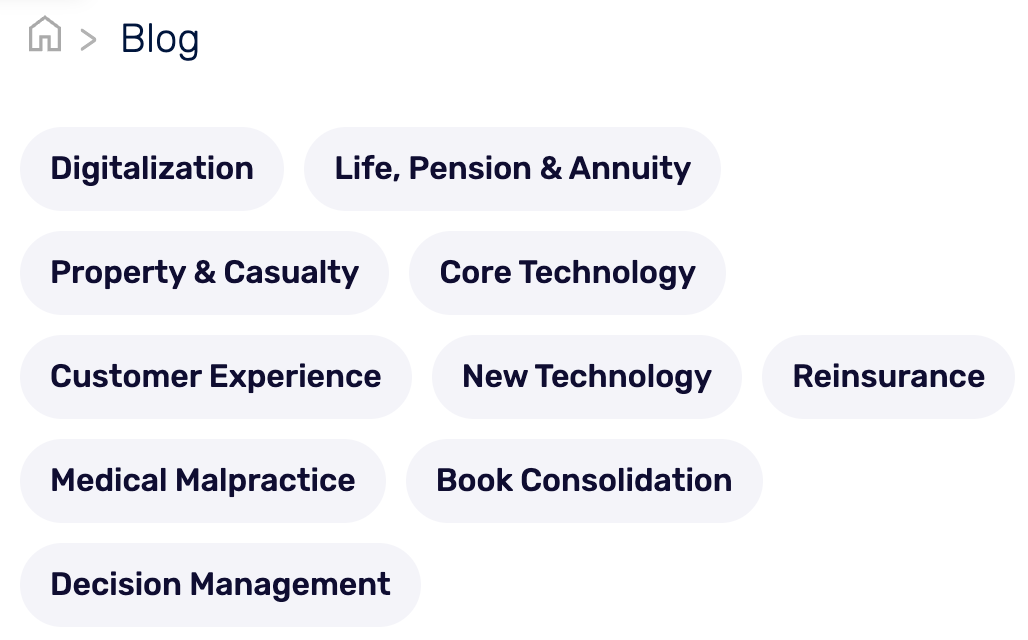
How often do they post?
Sapiens posts around 4-6 blog articles per month.
Their articles tend to be around 1,000 words long and include backlinks to well-known publications and thought leaders like Deloitte to support their arguments. They also incorporate statistics into their articles.
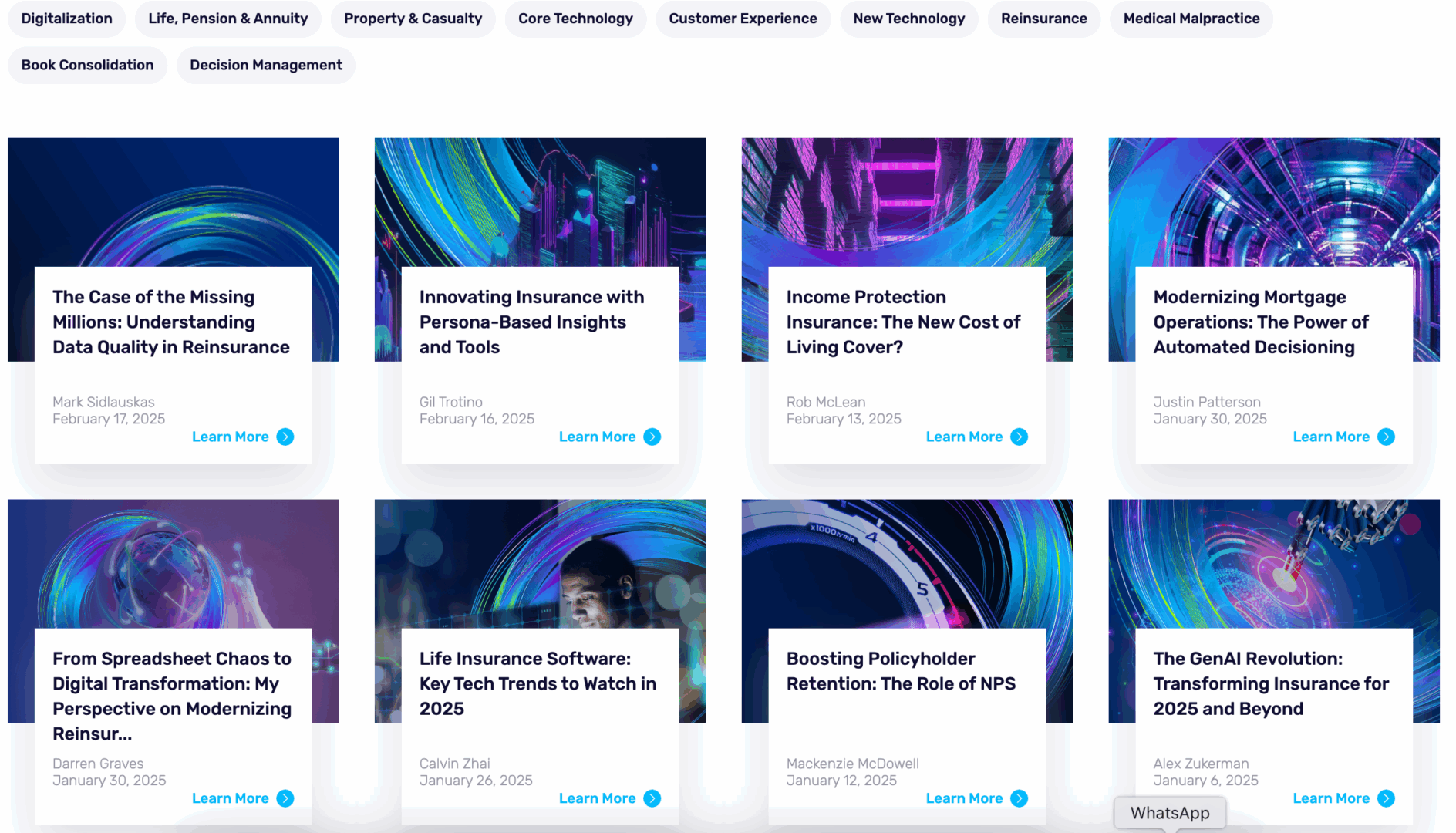
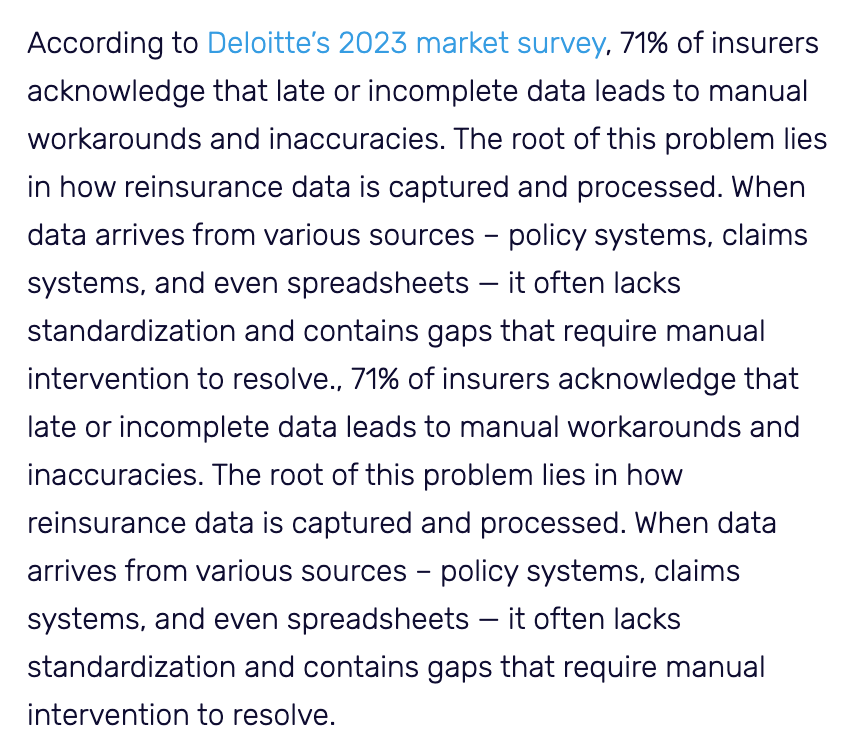
In terms of content structure they use 5-6 Heading 2.
Some, but not all, articles conclude with a direct sales pitch. When a call to action (CTA) is present, it tends to be a soft sales pitch. An example of this is the phrase “Those leveraging adaptable, AI-powered core systems like Sapiens CoreSuite for Life & Pensions will lead the charge, offering IP products that are flexible, affordable, and aligned with today’s workforce realities”.
Sometimes, they are a bit more direct: “Discover how Sapiens and SPLICE Software can help retain customers for greater market share and sustainable growth. Check out the Sapiens partner page to learn more.” Their content is slightly promotional, but not overly salesy.
On the article pages, Sapiens recommends readers other articles from the same category which they might enjoy (“People who read this also visited”).
The idea behind this feature is to increase engagement. This way Sapiens encourages users to stay on the platform longer and explore more, maybe eventually will land on their “Contact us” page. Also, it is another strategy to give visibility to articles and posts that might not otherwise be seen by a wider audience.
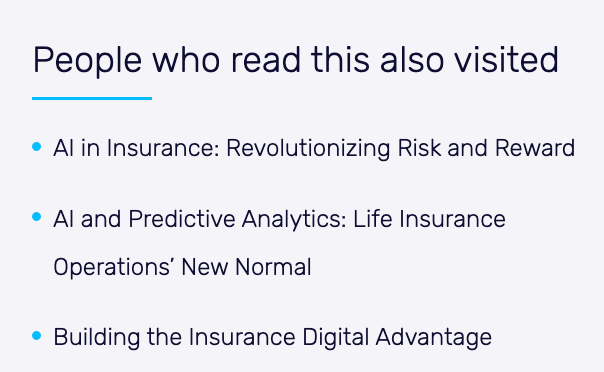
Their tone of voice is quite neutral and the language is clear, concise, and avoids jargon (except for the necessary industry terms like “Net Promoter Score”).
They are also using words like “imperative”, “essential”, and “significant“, to add weight to the arguments.
Resource Hub
In this section we have the following resource types: White-papers and e-books, Case Studies, Videos, Insights and On-demand webinars.
They write about different topics, quite a lot actually. You can check them all out here.
White-papers
White-papers are used as a lead magnet, because to access them, leads are required to input their contact details (see below).
Sapiens can then use this information to:
- Nurture leads through email marketing, providing further valuable content and building relationships.
- Qualify leads based on their industry, company size, and other factors.
- Pass qualified leads to the sales team for follow-up and potential conversion into customers.
They have a short copy where they try to “convince” the leads to download the white-paper.
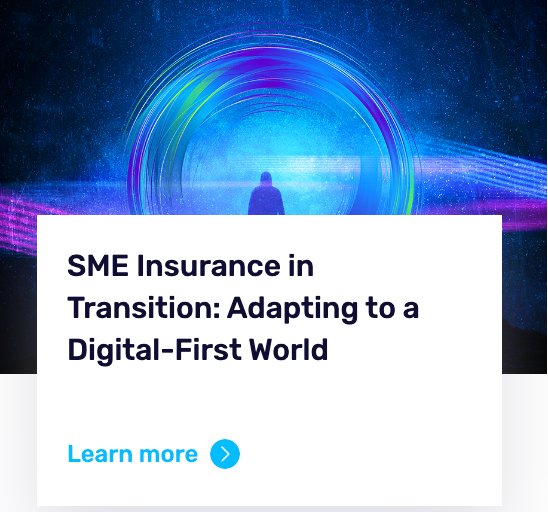
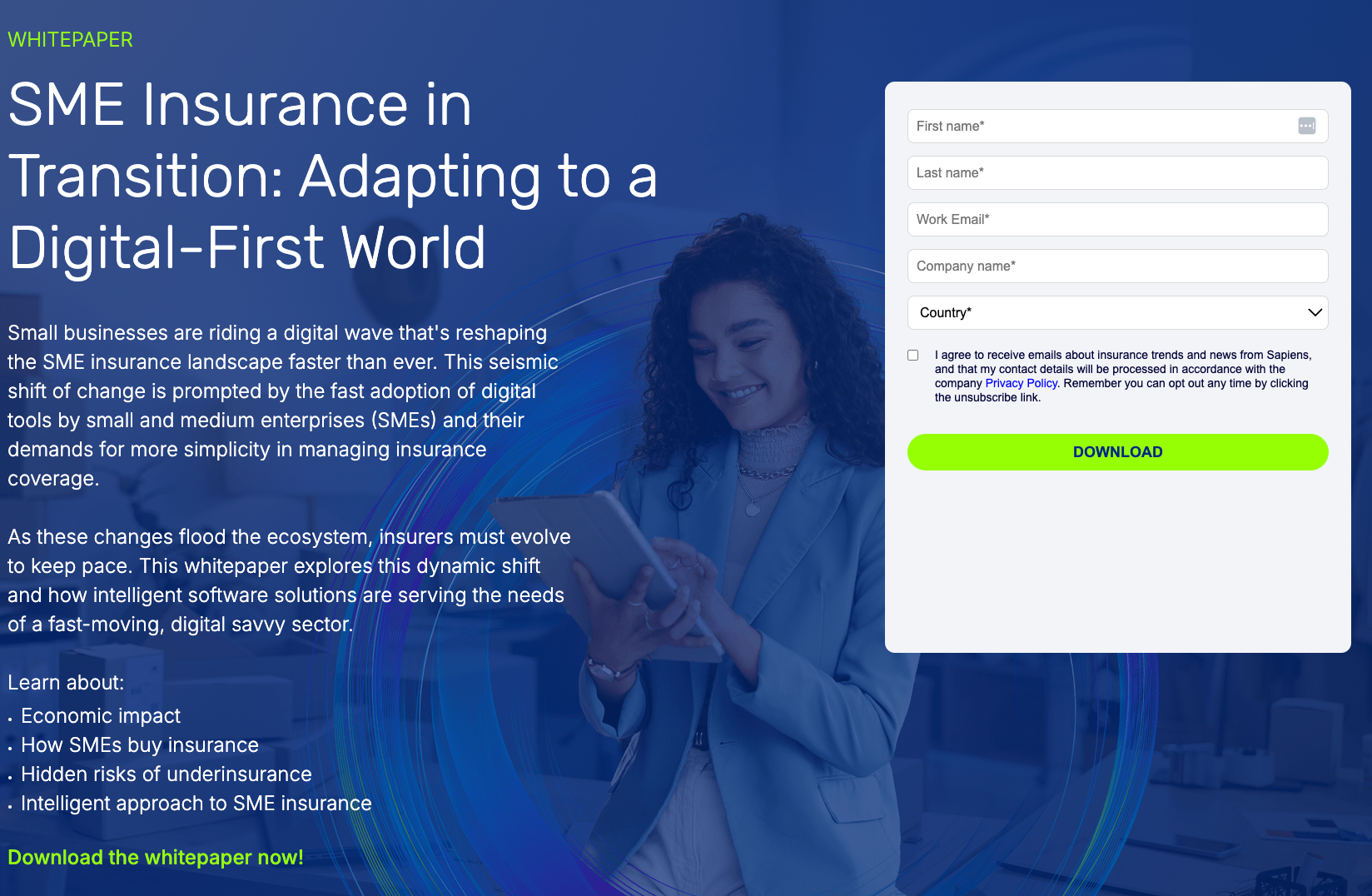
The CTA is also present: “Download the white-paper now!”
Case studies
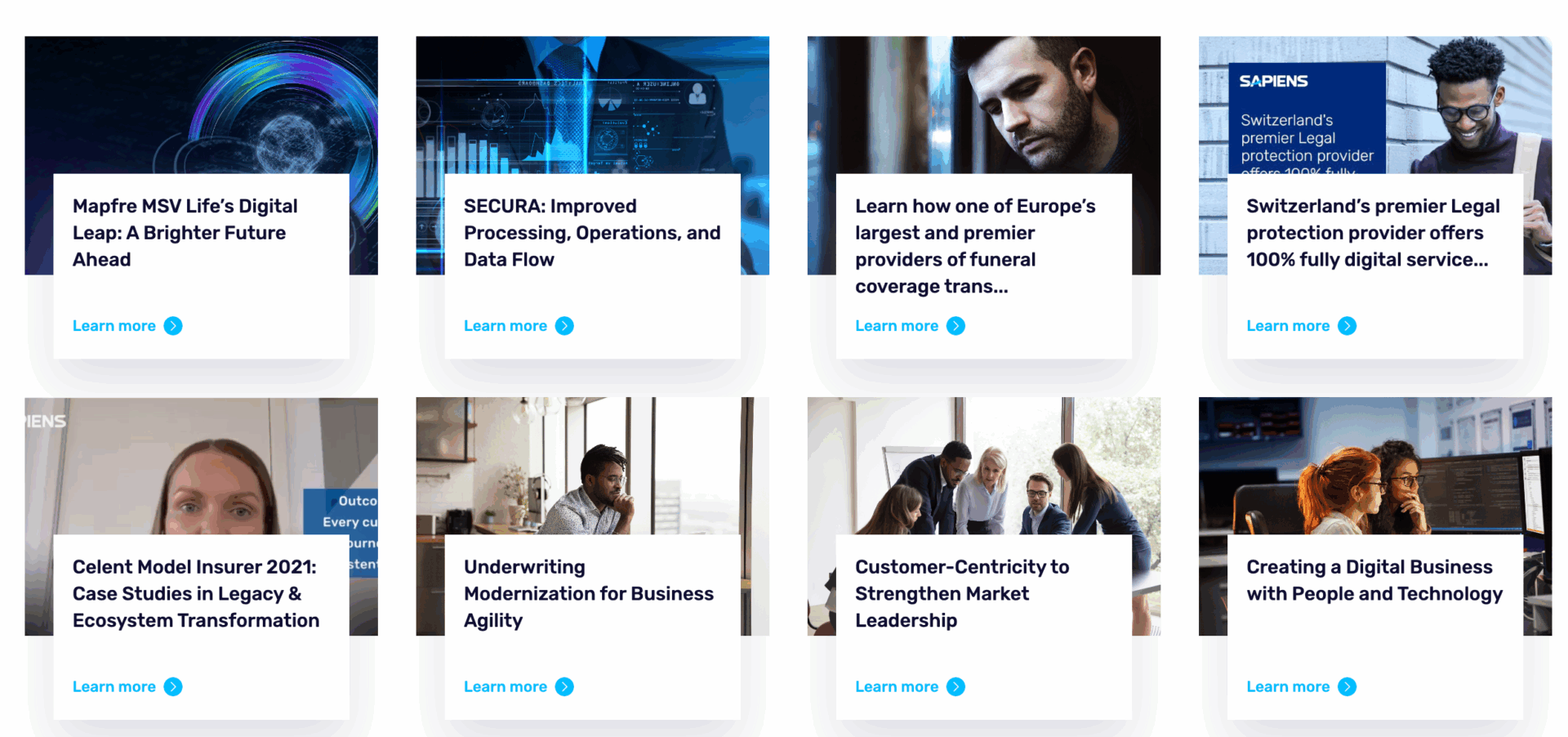
Accessing their case studies is free, and leads don’t need to input any details. When accessing a case-study, a 2-page PDF will open in your browser.
The structure is the following:
- The Clients
- The Challenge
- The Solution
- The Benefits
At the end of the case study, they have a dedicated space for their sales pitch and their: “About us” section. The “About Sapiens” section emphasizes their long history (“four decades”), wide customer base (“more than 600 global customers”), and proven ability.
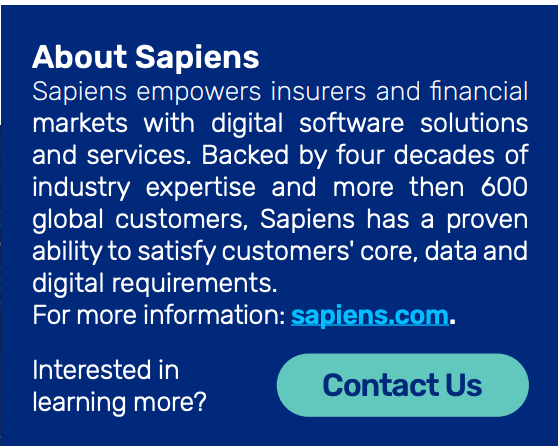
The “Interested in learning more?” section with a “Contact Us” button is a direct call-to-action, encouraging engagement and lead generation. The information is presented concisely and directly, respecting the reader’s time and attention.
Videos
This is an interesting section, because it is totally different from their webinars, focused on Video content.
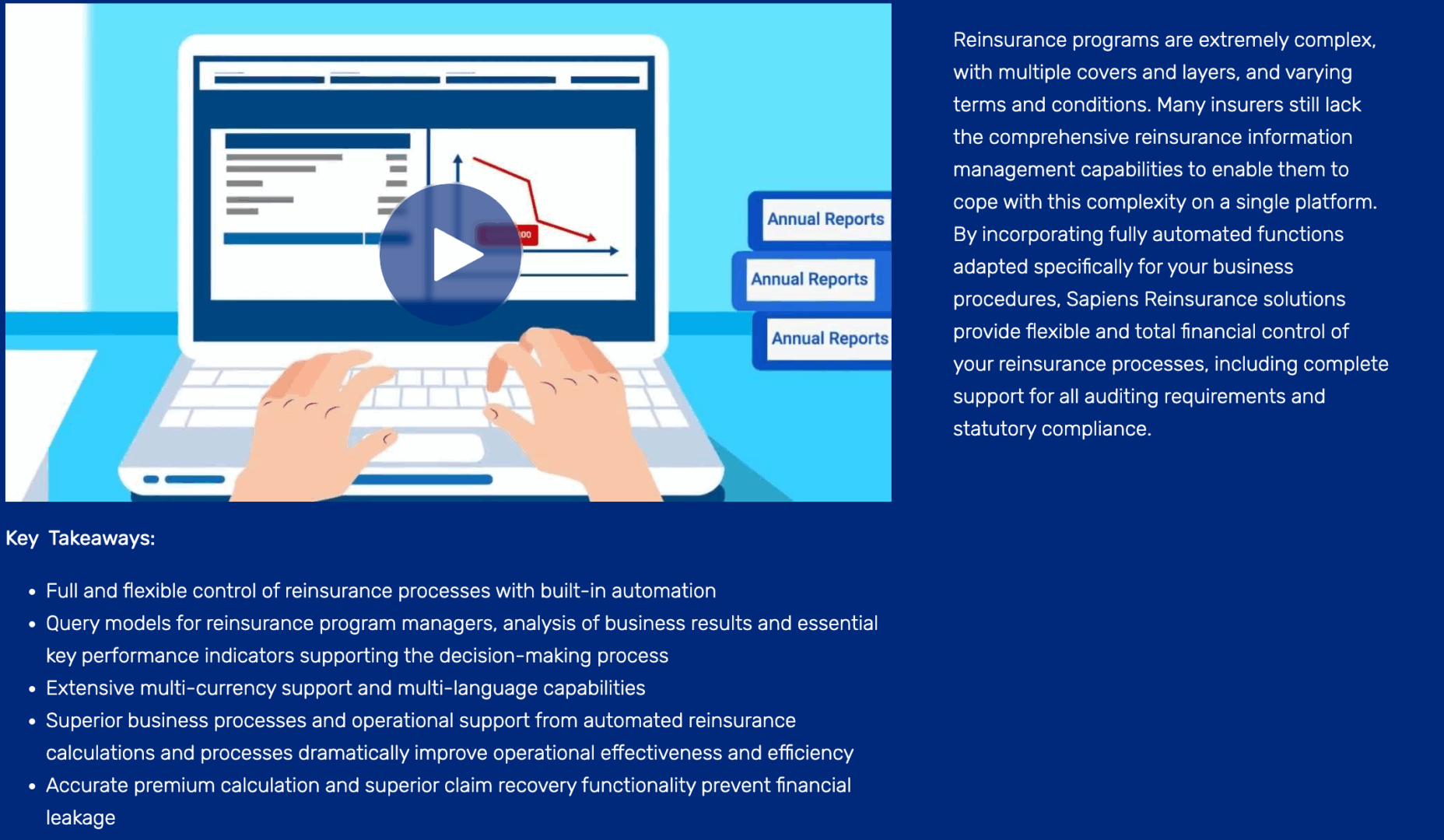
In this section they present their platform capabilities or discussion between C-lvl executives. Beside the main content, the video, Sapiens decided to post some key takeaways from the video. We like this idea, because this way leads don’t have to watch the whole video again, even thought it’s short (around 2 minutes).
While there isn’t a direct “Contact Us” button on this specific section, at the end of the video they add the following phrase: “Contact us for more details or to schedule a demonstration”.
Why did they decide to go with video content? Well, video is a highly engaging format. People are more likely to watch a video than read a block of text. It captures attention and can hold interest more effectively.
Insights
The category “Insights” on a business website, especially one like Sapiens that operates in the B2B space (business-to-business), typically means a collection of content designed to share expertise and thought leadership.
Here we have only 3 resources.
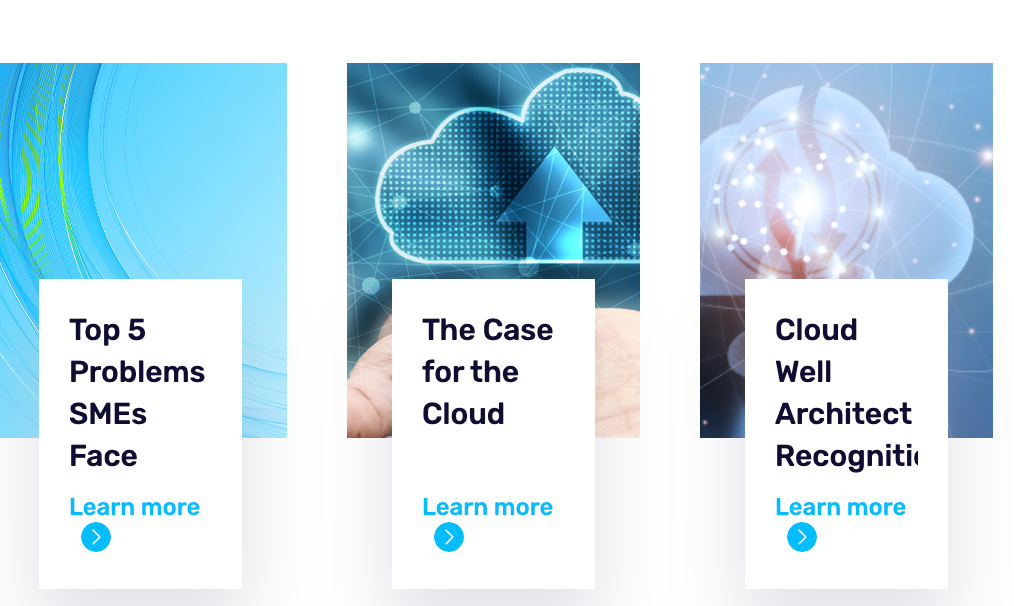
Sapiens has these short, few pages PDF reports. They’re basically giving out quick tips or industry insights, like “How to make your workload better”.
At the end of the article, we will find their CTA:

Similar to their case studies, at the bottom of the page, we will also find their “About Sapiens” section, including their sales pitch.
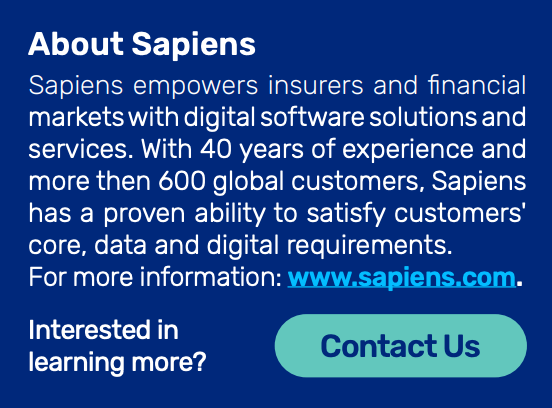
Podcast
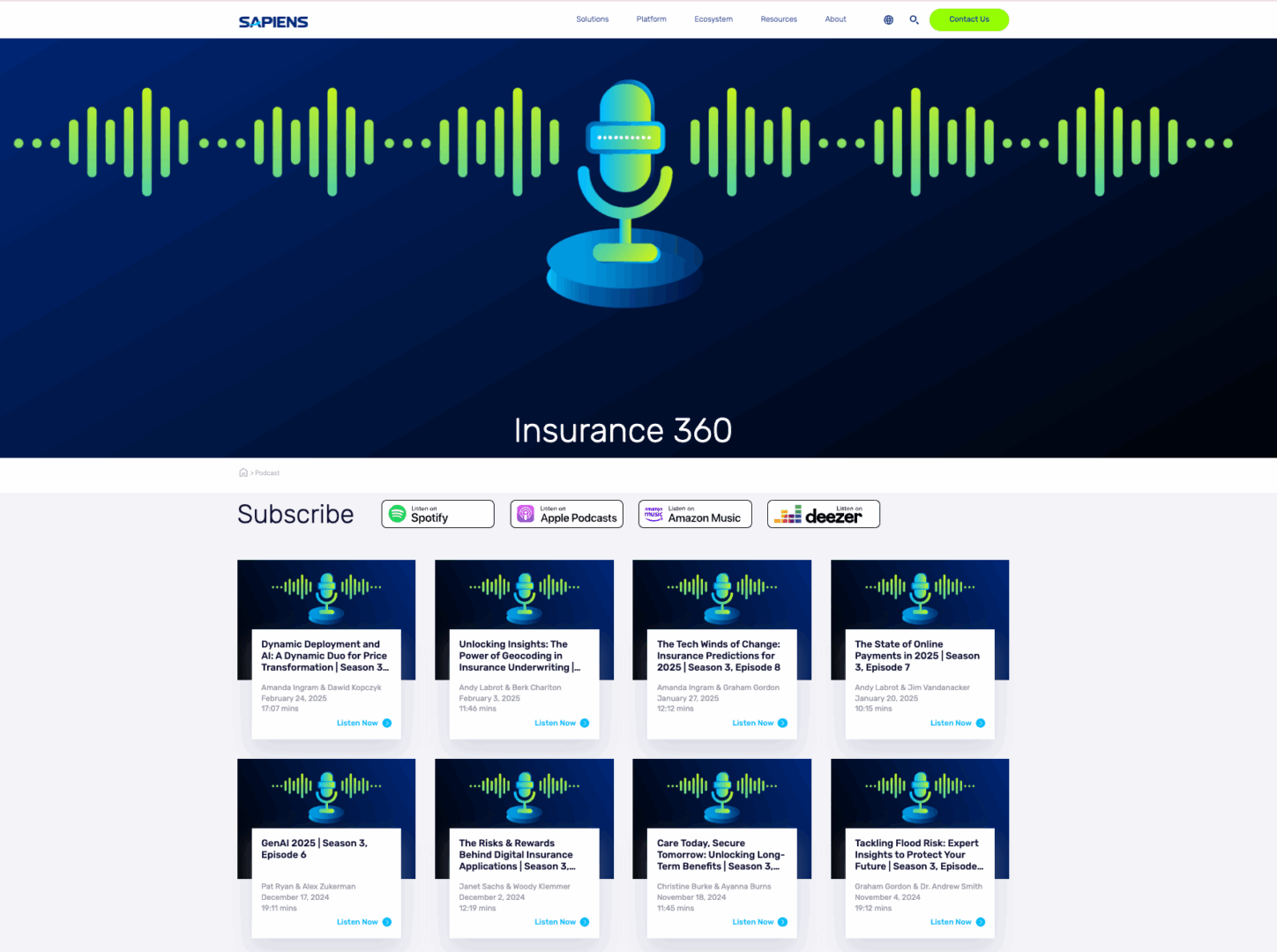
Sapiens has a podcast called ‘Insurance 360.’ They’re pretty active, and you can find them on Spotify and Apple Podcasts. They seem to stick to a schedule, dropping two episodes a month. They’ve got three seasons so far, about 15 episodes each. Short and sweet, usually under 20 minutes.
They have different hosts, but Amanda Ingram does most of the interviews. She is the P&C Product Strategy & Marketing Manager. The guests are either Sapiens’ employees, C-lvl positions, or CEOs of different companies.
The Insurance 360 podcast leverages Sapiens’ deep industry expertise to position the company as a leader in insurance technology. Each episode features discussions on critical trends such as generative AI, geocoding, flood risk modeling, and digital payment adoption. For example, the episode GenAI 2025 explores the long-term viability of generative AI in claims processing and underwriting, with insights from Sapiens’ Chief Strategy Officer Alex Zukerman.
At the end, the hosts invite listeners to subscribe to their podcast and channels.
Conclusions
Sapiens generates demand through their content marketing strategy which includes blog posts, white papers, case studies, and videos, that address the challenges and opportunities facing insurance companies. This content is also thought leadership content, because it is created to position them as experts in the field.
We can also see lead generation strategies, when they use valuable resources, such as white papers and webinars, in exchange for contact information. This way they can capture leads and nurture them through the sales funnel.
Lead generation
In this section we will analyze how they are generating leads.
Webinars
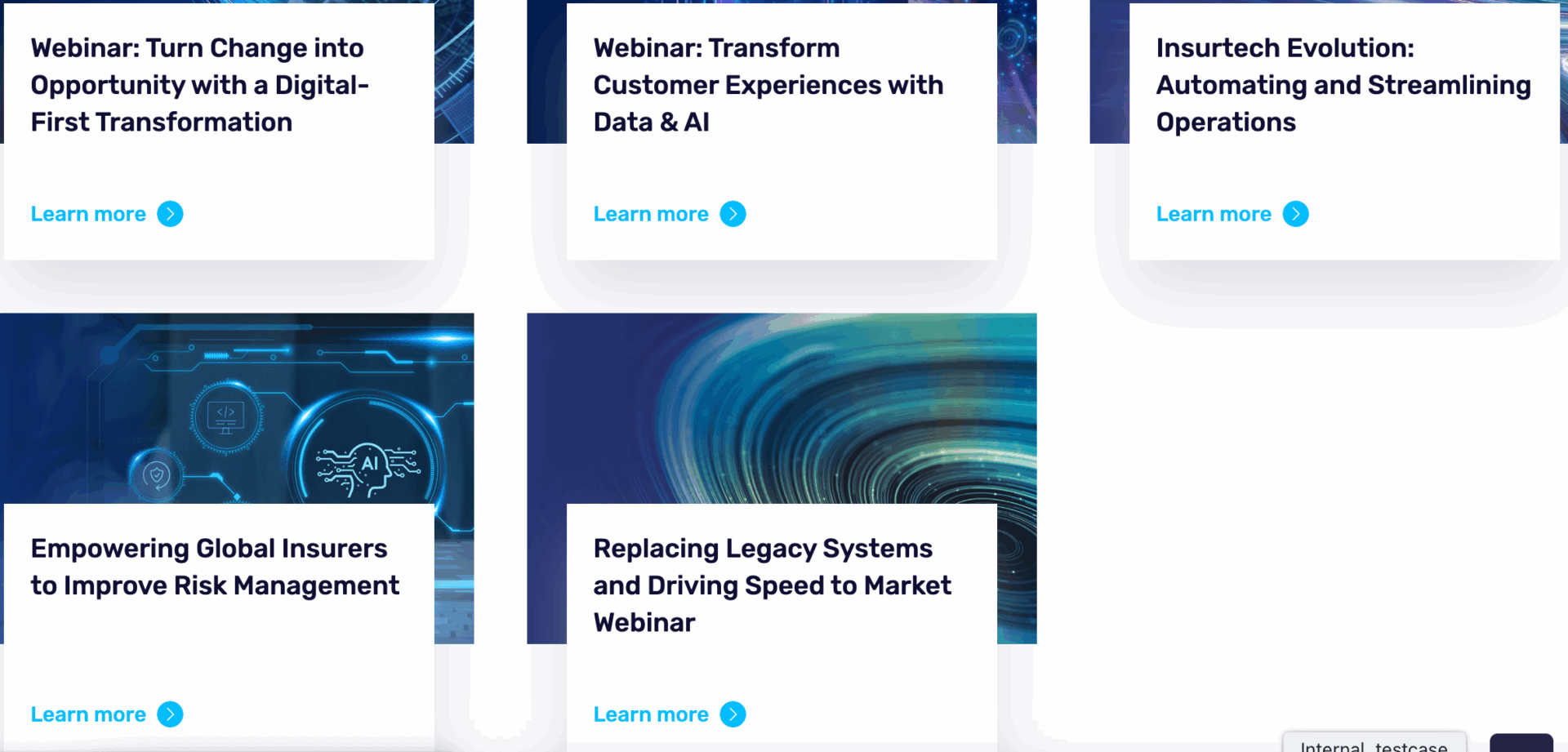
First, let’s understand why webinars are effective for lead generation. When a company organizes a webinar, they have in mind different purposes. First, they want to have unique opportunity to interact, in real-time, with potential customers. This means engaging with the audience directly, building trust, answering their questions, providing answers and inserting calls to actions in their speech. People who sign up for webinars are typically interested in the topic and have taken an active step to engage with your brand. This pre-qualifies them as potential leads, making them more likely to convert into customers.
Another reason must be becoming an authority in their niche. Webinars provide valuable insights and educational content that address specific pain points or interests of the audience.
Now, Sapiens organizes live webinars, but they also have on-demand webinars. The live webinars are promoted on LinkedIn.
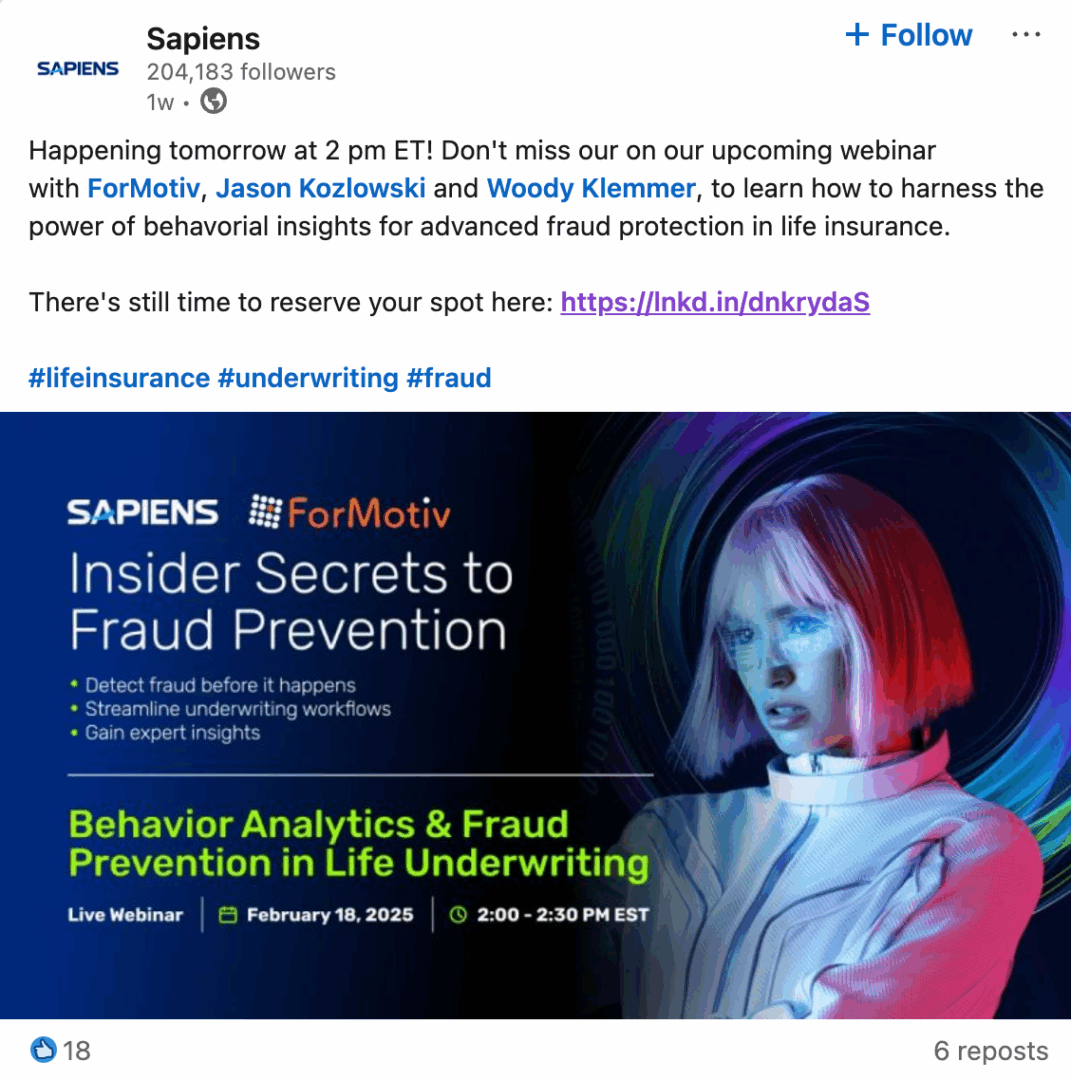
Each webinar has a dedicated landing page, where the leads can register. On this landing page they have a short copy, about the webinar, the experts and key take aways. Leads are required to sign up by filling in a form:
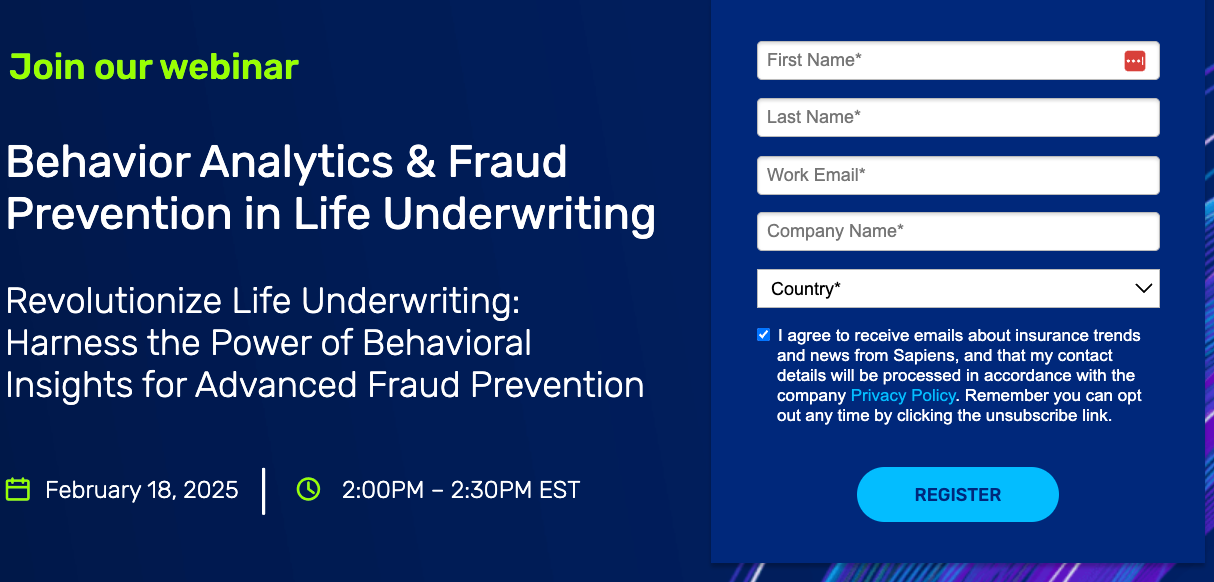
When it comes to on-demand webinars, we can find them on their website in the resource center. The length of the webinar is unknown.
They follow the same strategy, the webinar being available only after the leads have filled in a form. After that, they are allowed to download the webinar.
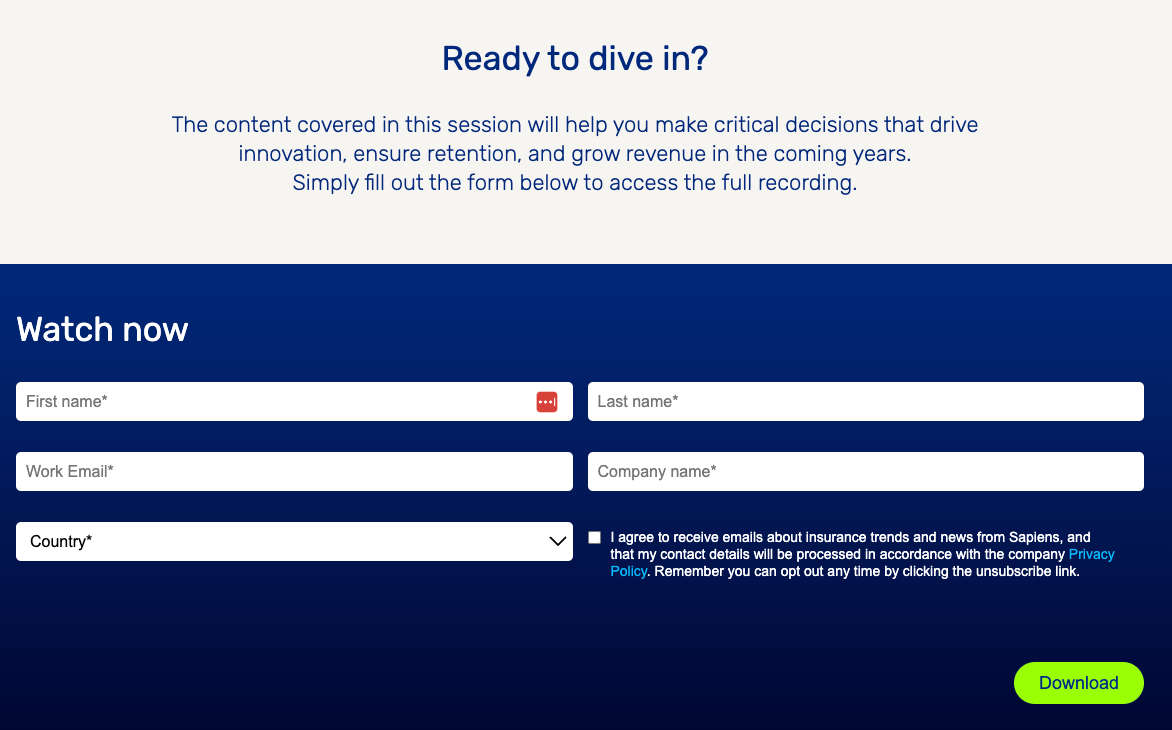
Until now they have 5 on-demand webinars.
Their “live webinars” which are posted and promoted on LinkedIn are transformed into “on demand webinars”. As you can see below, the same webinar promoted on LinkedIn is found on their webinar page on their website.
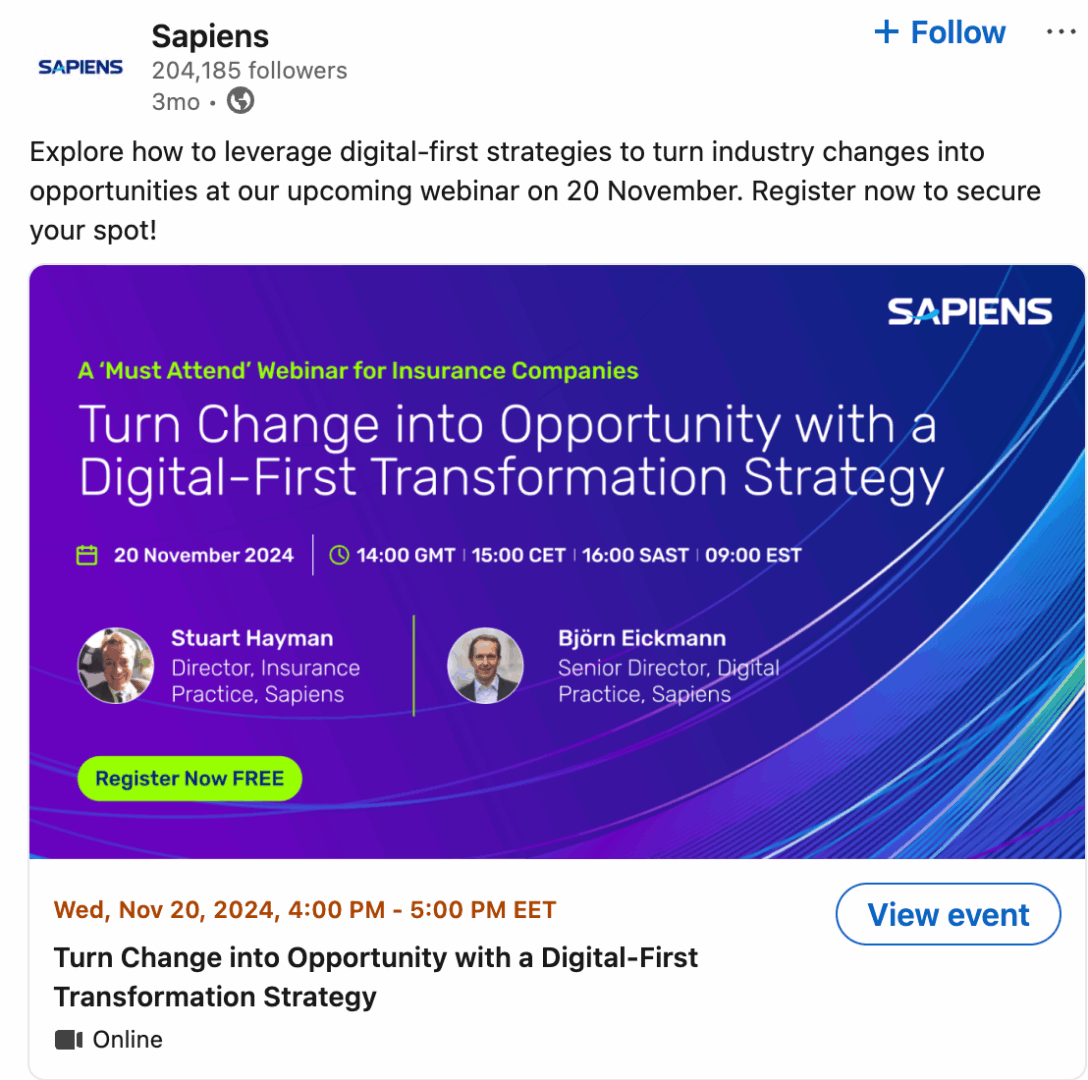

Paid Advertising
Now we move on and analyze Sapiens’ Ad library.

On LinkedIn Sapiens has 827 ads.
Immediately we can observe that they use both videos and articles as promotional material. Most of their images they use for their ads have a strong CTA visual, such as: “Learn More”, “Find out how”, “Learn how”, and “See how we can help!”.
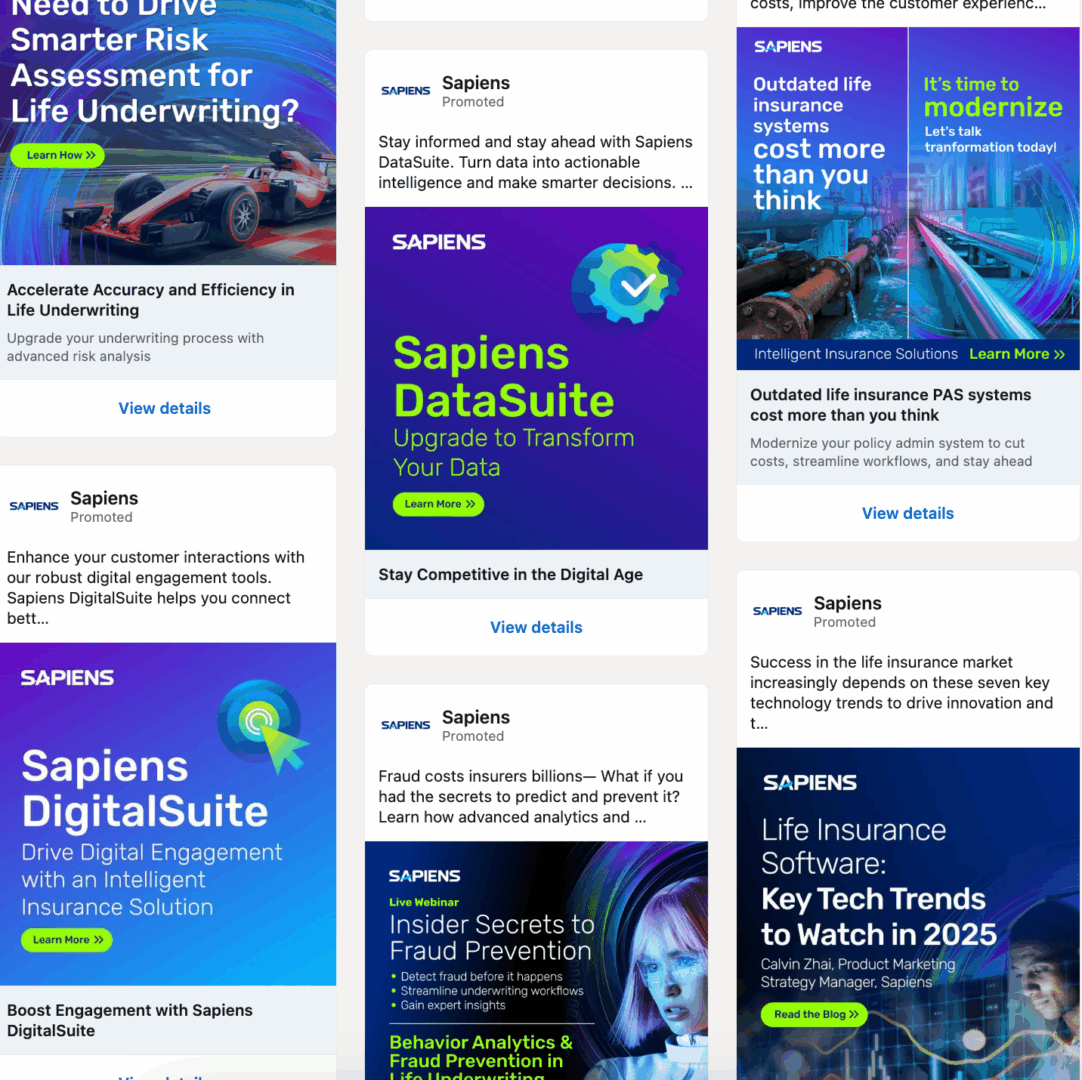
In some ads they are promoting their services, such as “Life insurance”. As we click on the “View details” button, we are redirected to this landing page, where we find out more about this particular service. They also use a pop-up after a few seconds asking for leads to contact them if they need some extra info. The CTA is “Contact us”, as you can see below:
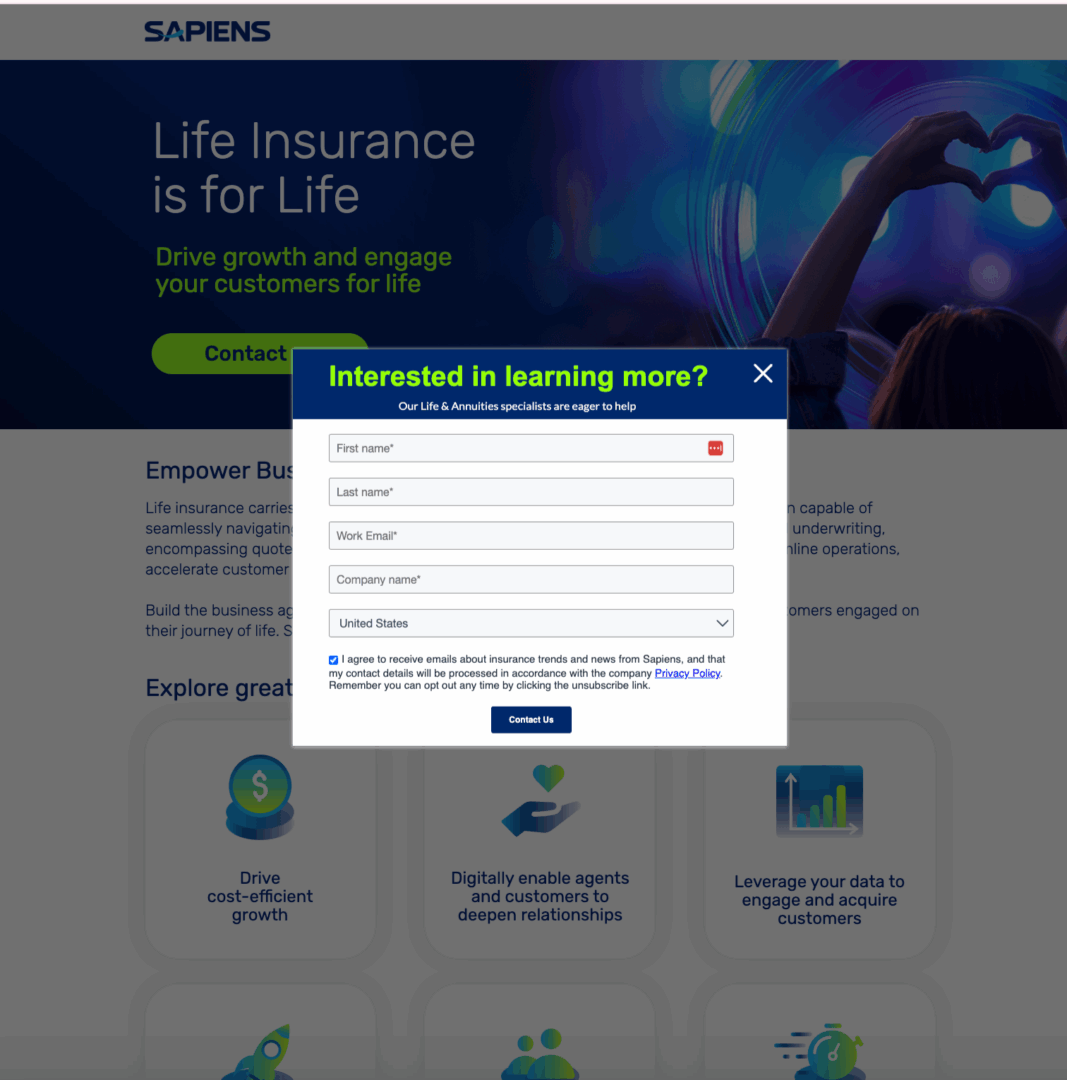
They have pre-checked boxes for receiving emails. This can lead to recipients receiving unwanted emails, which they may not have intended to sign up for.
Some ads don’t perform quite amazingly, because they have less than 1k views, such as this one. However, most of their ads get between 10K-50K.
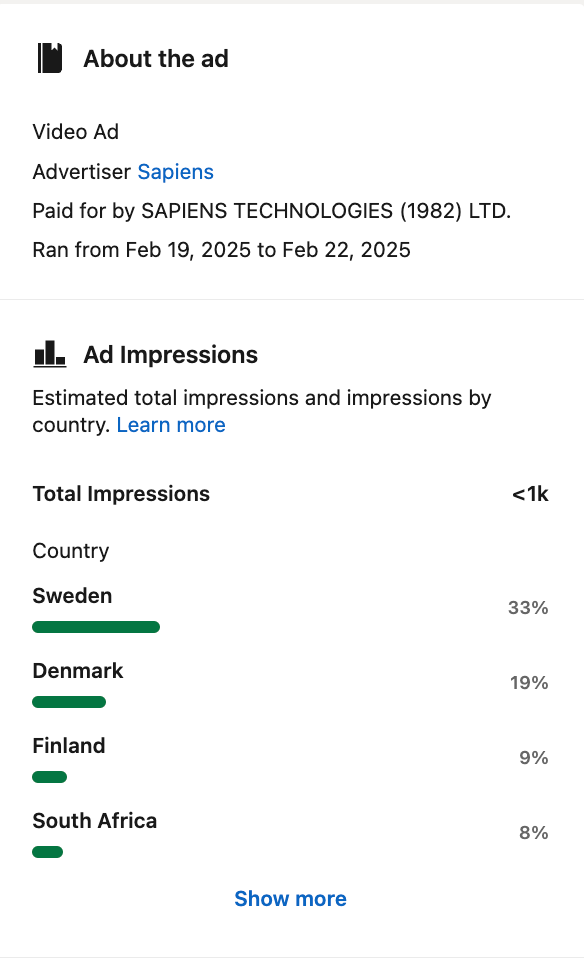
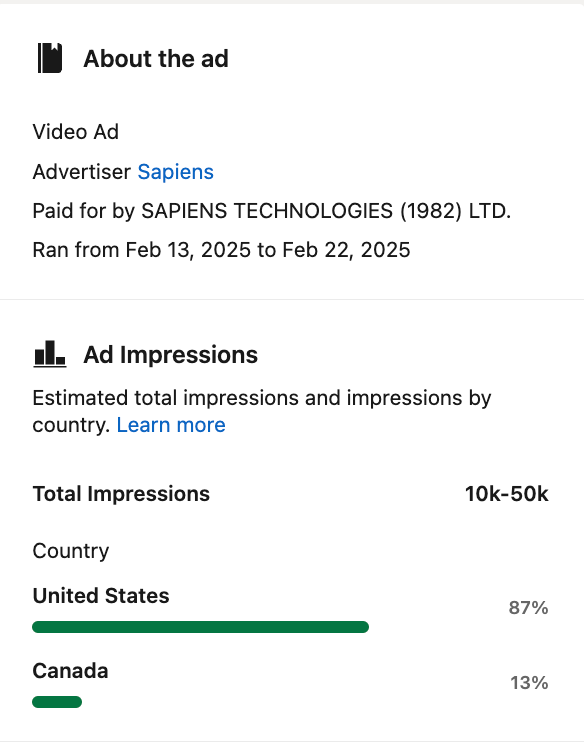
They also promote their life insurance software, jobs, underwriting solutions, modernizing legacy systems, tech trends, and more.
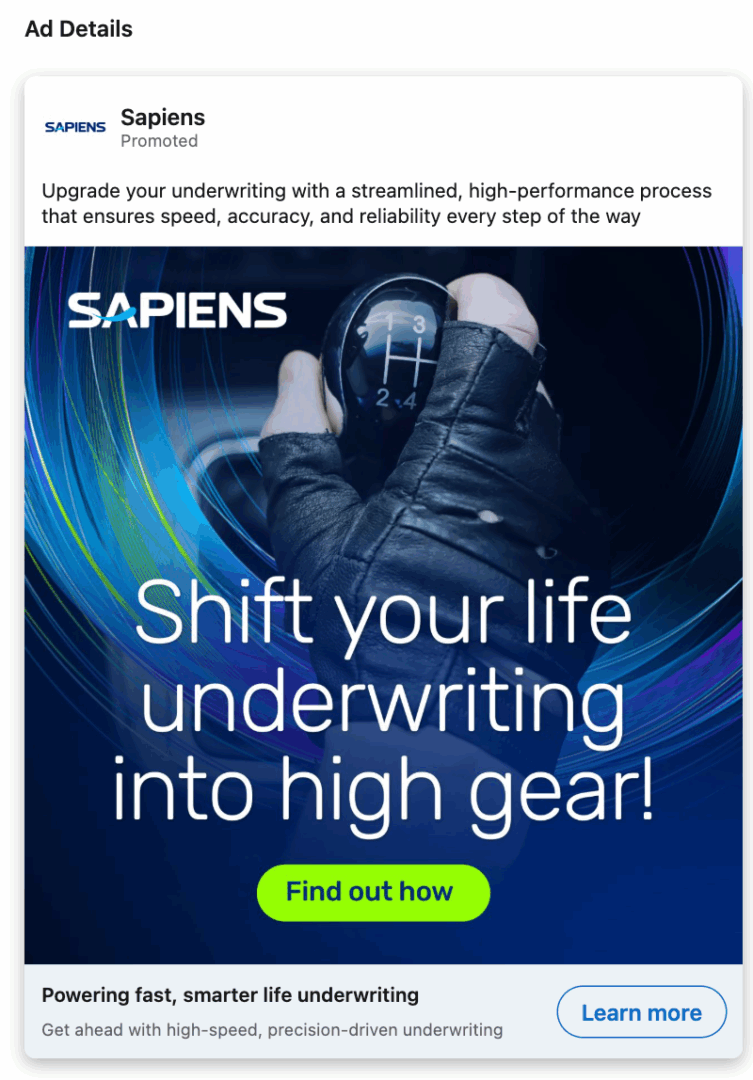

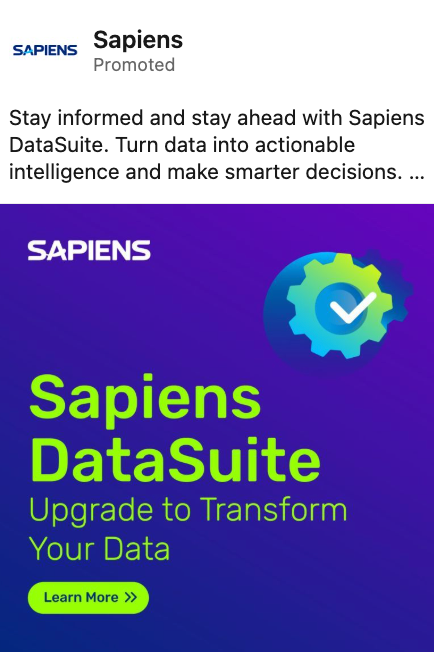
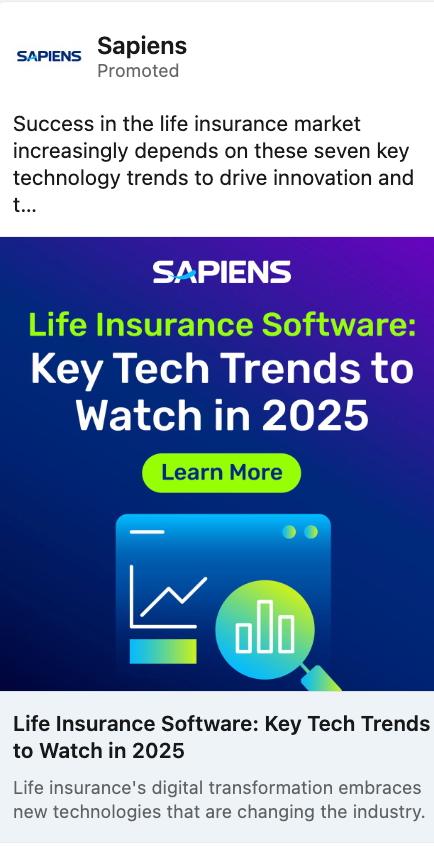
Conclusions
Sapiens uses white papers as lead magnets, requiring contact information for access. This creates a clear value exchange and helps them capture qualified leads interested in specific topics.
Their webinar strategy works on two levels: live webinars promoted on LinkedIn, and on-demand webinars available through their resource center. Both require registration, creating multiple opportunities to collect lead information.
With over 800 ads on LinkedIn, they’re clearly invested in paid lead generation, though with mixed results, with views that range from under 1K to 50K. Their ads feature strong calls-to-action like “Learn More” and “Find out how” to encourage clicks.
They also use contact forms and pop-ups on their service pages to capture leads who are already showing interest in specific solutions.
Strategy overview
Looking back at the analysis, Sapiens’ content strategy is designed with both demand generation and lead capture in mind.
First, they use content to create awareness and demand through:
- Regular blog posts (4-6 monthly) that address industry challenges and position them as experts
- The “Insurance 360” podcast covering critical industry trends
- Thought leadership content highlighting their expertise in insurance technology
- Case studies demonstrating real-world solutions (which are freely accessible)
- Videos featuring platform capabilities and executive discussions
Then, they capture the interest they’ve generated through:
- Gated white papers requiring contact information
- Webinar registrations (both live and on-demand)
- LinkedIn ads with strong CTAs directing to landing pages
- Contact forms on service-specific pages
- Pop-ups that appear after visitors engage with content
Recommendations for Digital Marketing Strategy
- Develop industry-specific content pillars. Just as Sapiens creates targeted content for different insurance verticals, B2B SaaS companies need to create defined content themes addressing specific pain points their own clients have, because when you speak to their specific challenges, they instantly see the value, and that’s how you get more conversions.
- Try to come up with strategic content gating. Not all content should require contact information. Create a balance between freely accessible content (blogs, case studies) to build trust and gated premium content (white papers, research reports) to capture leads.
- Create a lead scoring and nurturing system. Not all leads are equal. Implement systems to identify which leads are most promising, then create targeted nurture campaigns to move them through the funnel at the right pace. Here you can also use Account-Based Marketing (ABM) strategies.
How does ABM work? Well, instead of trying to catch any lead that comes your way, you’re specifically targeting certain companies that you’ve identified as ideal customers. Now, when you combine this with lead scoring, you’re essentially adding another layer to your approach. Lead scoring helps you understand which individual people at these target companies are most interested in what you offer.
The beauty of combining ABM with lead scoring is that you’re not just identifying which companies to target, but also which specific people within those companies are most ready for a conversation. This means your sales team spends their time talking to the right people at the right companies at the right time. Milk and Cookies Studio can help set up this kind of system for your clients, ensuring they’re engaging with high-potential accounts in the most effective way possible.
If you’re nodding along but wondering how to put these lead generation and ABM approaches into practice, you’re not alone. Many B2B SaaS companies understand the importance of these strategies but struggle with implementation, resources, or expertise. At Milk and Cookies .Studio, we blend strategic thinking with practical execution to help companies like yours transform their marketing approach.
Let’s have a conversation about where you are today and where you want to be. No pressure, just cookies and solutions. 🍪
FAQ
1. What does Sapiens do?
Sapiens is a global provider of intelligent insurance software solutions, helping insurers grow, differentiate, and stay future-ready with AI-powered, cloud-native platforms and industry expertise.
2. What is Sapiens’ brand promise?
Sapiens promises to empower insurers to grow and innovate with intelligent, open, and adaptable insurance solutions, emphasizing long-term partnerships and unmatched industry expertise.
3. How does Sapiens differentiate itself?
Sapiens differentiates itself through recognition by industry experts, partnerships like Microsoft’s Top 100, and a strategic focus on supporting clients throughout their transformation journey.
4. How active is Sapiens on social media?
Sapiens is highly active on LinkedIn with around 39 posts per month, focusing on events, services, partnerships, and webinars. They also maintain a presence on Instagram, Facebook, X, and YouTube with tailored content per platform.
5. What are Sapiens’ content marketing and lead generation strategies?
Sapiens uses thought leadership and lead generation strategies through blog posts, gated whitepapers, case studies, videos, on-demand webinars, LinkedIn ads, and CTAs on landing pages. These tactics attract leads and nurture them through the sales funnel.


